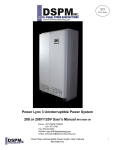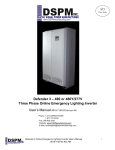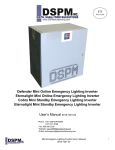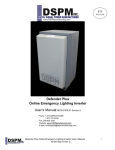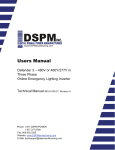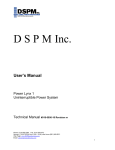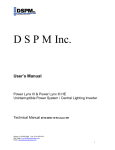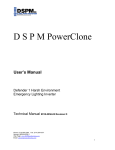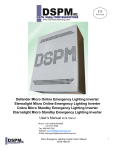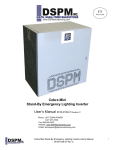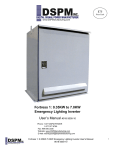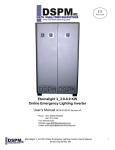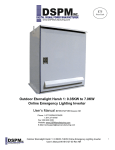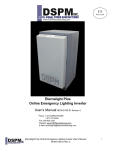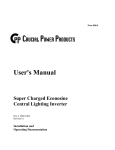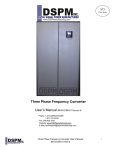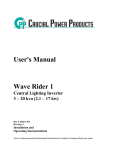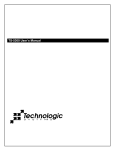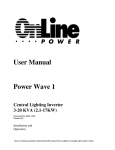Download Maintenance Manual 208V
Transcript
$75 Price Each Defender 3 Online Emergency Lighting Inverter Eternalight 3 Online Emergency Lighting Inverter Cobra 3 Standby Emergency Lighting Inverter Eternalight 3 Standby Emergency Lighting Inverter 208 or 208Y/120V Maintenance Manual #074-9000-00 Phone: 1.877.DSPM.POWER 1.877.377.6769 Fax: 909.930.3335 Website: www.DSPManufacturing.com E-Mail: [email protected] Three Phase Emergency Lighting Inverter Maintenance Manual #074-9000-00 1 TABLE OF CONTENTS TABLE OF CONTENTS 2 REVISION HISTORY 4 REPRODUCTION OR DISTRIBUTION FORBIDDEN 5 ABOUT THIS MANUAL 6 SECTION HOW TO USE THIS MANUAL SECTION TECHNICAL ASSISTANCE 6 6 IMPORTANT SAFETY INSTRUCTIONS 7 SECTION 7 NOTES AND SAFETY INFORMATION CHAPTER 1 INTRODUCTION 11 SECTION 1.1. GENERAL SECTION 1.2. DEFINITIONS SECTION 1.3. THEORY OF OPERATION SECTION 1.4. OUTPUT LOADS SECTION 1.5. OPTIONS SECTION 1.6. OVERVIEW FIGURE 1—SINGLE-LINE DRAWING-NORMAL OPERATION SUBSECTION 1.6.A. NORMAL OPERATION SUBSECTION 1.6.B. MANUAL BYPASS OPERATION FIGURE 2—SINGLE-LINE DRAWING-MANUAL BYPASS SUBSECTION 1.6.C. AC LOSS/BATTERY OPERATION FIGURE 3—SINGLE-LINE DRAWING-AC LOSS/BATTERY OPERATION SUBSECTION 1.6.D. EXTERNAL MAINTENANCE BYPASS OPERATION (OPTIONAL) FIGURE 4—SINGLE-LINE DRAWING-EXTERNAL MAINTENANCE BYPASS OPERATION 11 11 12 13 13 13 14 14 14 14 14 15 15 15 CHAPTER 2 SPECIFICATIONS 16 TABLE 1—SPECIFICATIONS SECTION 2.1 POWER RATING SECTION 2.2 INPUT SECTION 2.3 OUTPUT SECTION 2.4 BATTERIES SECTION 2.5 LAMPS AND LOADS SECTION 2.6 CODES SECTION 2.7 PROTECTION SECTION 2.8 DIAGNOSTICS AND MAINTENANCE SECTION 2.9 CABINET SECTION 2.10 INSTALLATION SECTION 2.11 SPECIAL APPLICATIONS SECTION 2.12 WARRANTY 16 16 16 16 16 16 16 16 17 17 17 17 17 CHAPTER 3 FIELD REPLACEABLE UNITS (FRUS) 17 Three Phase Emergency Lighting Inverter Maintenance Manual #074-9000-00 2 SECTION 3.1 SECTION 3.2 MOTHER/MAIN BOARDS ALL OTHER PARTS 17 17 CHAPTER 4. DISPLAYS 18 SECTION 4.1 FRONT PANEL DESCRIPTION FIGURE 4—FRONT PANEL DISPLAY SECTION 4.2 LCD PANEL MONITOR DISPLAY FIGURE 5—LCD MONITOR DISPLAY SECTION 4.3 HISTORY LOG KEY TABLE 2—HISTORY LOG KEY 18 18 18 18 19 19 CHAPTER 5 OPERATION AND PROCEDURE 21 SECTION 5.1. START-UP PROCEDURE SECTION 5.2. SHUT-DOWN PROCEDURE SECTION 5.3. STANDBY MODE PROCEDURE SECTION 5.4. MANUAL BYPASS MODE PROCEDURE 21 21 21 22 CHAPTER 6 MAINTENANCE 23 SECTION 6.1. SAFETY PRECAUTIONS SECTION 6.2. WHEN TO CALL SECTION 6.3. STEPS TO TAKE SECTION 6.4. PREVENTATIVE MAINTENANCE SUBSECTION 6.4.1. MAINTAINING AN OPERATOR’S LOG SUBSECTION 6.4.2. PERIODIC TESTING OF UPS SUBSECTION 6.4.3. MAINTAINING BATTERIES LOG FIGURE 6—BATTERY RESISTANCE AND CAPACITY TESTER SUBSECTION 6.4.4. RECORDING ENTRIES INTO BATTERIES LOG LOG 1—BATTERIES MAINTENANCE LOG 2—OPERATOR’S MAINTENANCE FIGURE 7—WATER DOT EXAMPLE SUBSECTION 6.4.5. MAINTAINING THE BATTERIES SUBSECTION 6.4.6. CHARGING OF THE BATTERIES 23 24 24 24 24 25 25 25 25 30 30 30 32 33 CHAPTER 7. SYSTEM OPTIONS 34 SECTION 7.1. UNIT OPTIONS SECTION 7.2. SERVICE PROGRAM DESCRIPTIONS TABLE 3—SERVICE COVERAGE 34 37 40 CHAPTER 8. APPENDIXES 41 SECTION 8.1. FIGURES AND TABLES FIGURE 8a-f—PERFORMIX PLASTI DIP PROCESS FIGURE 9—BATTERY CABINET FIGURE 10a-b—SYSTEM LAYOUT SECTION 8.2. LIMITED WARRANTY SECTION 8.3. NOTES 41 41 42 43 44 47 Three Phase Emergency Lighting Inverter Maintenance Manual #074-9000-00 3 REVISION HISTORY REV DATE PRIMARY REASON FOR CHANGE NR October 30, 2014 New Release LIST OF EFFECTIVE PAGES PAGE REV PAGE REV PAGE REV PAGE REV PAGE Three Phase Emergency Lighting Inverter Maintenance Manual #074-9000-00 REV 4 Reproduction or Distribution forbidden NOTICE: THIS DOCUMENT CONTAINS PROPRIETARY INFORMATION This document contains proprietary and confidential information of Digital Signal Power Manufacturer, Inc. (”Digital Signal Power Manufacturer”). In consideration of the receipt of this document, the recipient agrees not to copy any of its contents, nor to disclose them to or allow them to be used by any person not currently an Digital Signal Power Manufacturer employee or an employee of the recipient having a need to know, without the express written consent of Digital Signal Power Manufacturer, and further agrees to surrender this document to Digital Signal Power Manufacturer when the reason for its receipt has terminated. © 2014 Digital Signal Power Manufacturer, Inc. - All rights reserved Three Phase Emergency Lighting Inverter Maintenance Manual #074-9000-00 5 About this Manual Thank you for selecting this Emergency Lighting Inverter System (ELI). It provides you with perfect protection for connected loads and equipment. This manual contains Important instructions that should be followed during maintenance of the DSPM Uninterruptible Power Supply. It includes important safety and maintenance instructions for operating the Emergency Lighting Inverter System. If you should have any problems with the Emergency Lighting Inverter System, please refer to this manual and/or call technical support. Your DSPM Uninterruptible Power Supply is designed to provide reliable protection from power disturbances for many years. Please be sure to follow the manufacturers instructions to ensure optimum performance of the equipment. This manual contains descriptions of all controls and indicators required to operate the DSPM Uninterruptible Power Supply. Please read this manual carefully and retain it for future reference. To the best of our knowledge and at the time written, the information contained in this document is technically correct and the procedures accurate and adequate to operate this instrument in compliance with its original advertised specifications. While every precaution has been made to ensure accuracy and completeness in this manual, DSPM assumes no responsibility and disclaims all liability for damages resulting from the use of this information or for any errors or omissions. This instrument is designed to prevent accidental shock to the operator when properly used. However, no engineering design can render safe an instrument which is used carelessly. Therefore, this manual must be read carefully and completely before making any measurements. Failure to follow directions can result in a serious or fatal accident. How to use this Manual This manual is designed for ease of use, giving the user easy and quick reference to information. This manual uses notice icons to draw attention to the user important information regarding the safe operation and installation of the UPS. The notice icons used in this manual are explained below, and should be taken into account and adhered to whenever they appear in the text of this manual. Technical Assistance Safety Recommendations: If any problems are encountered while following this manual, DSPM assistance and correspondence is recommended. For technical support or help with any questions not covered in the manual, contract. DSPM Inc. 1921 S. Quaker Ridge Place Ontario, CA 91761 Work Hours: 8 a.m. – 5 p.m. Pacific Standard Time Phone:1(877) DSPM POWER 1(877) 377-6769 After Hours: 5 p.m. – 1 a.m. Pacific Standard Time 1(951) 840-0811 Fax: 1(909) 930-3335 Email: [email protected] Internet: http://www.DSPManufacturing.com To expedite assistance if required, Please have the following information from your unit’s System Label (found on the right side and inside door panel) available: Model: Model Number: S/O Number: Input Voltage: Output Voltage: Power Rating and Frequency: Three Phase Emergency Lighting Inverter Maintenance Manual #074-9000-00 6 IMPORTANT SAFETY INSTRUCTIONS SAVE THESE INSTRUCTIONS SECTION - SAFETY Notes and Safety Information Following safety precautions is important when operating or servicing electrical equipment. Always heed these precautions since they are essential to the safe operation and servicing of this product. This Manual contains warning symbols which alert the user to check for hazardous conditions. The symbols are used extensively throughout this manual and are defined below. To ensure the safety of operating performance of this electrical equipment, these instructions must be adhered too. WARNING: A Warning notice icon conveys information to protect the user and service personnel against hazardous conditions. DANGER: A Danger notice icon conveys that there is a risk of electric shock, personal injury, or death to the user if instructions are not followed. CAUTION: A Caution notice icon conveys to the user or service personnel information making them aware that there is a possibility of equipment damage. NOTE: A Note notice icon indicates when the user should make a reference of information regarding the UPS operation, load status and display status. Such information is essential if DSPM, Inc. field service assistance and correspondence is required. CAUTION! ENSURE THAT NO FLUIDS OR OTHER FOREIGN OBJECTS CAN ENTER THE INVERTER SYSTEM. NOTE! READ THIS MANUAL IN ITS ENTIRETY BEFORE PERFORMING THE INSTALLATION, START-UP, OPERATION, OR MAINTENANCE OF THE UPS (Uninterruptible Power System) OR BATTERY SYSTEMS. FAILURE TO DO SO COULD RESULT IN ELECTROCUTION, FIRE, EXPLOSION, OR EQUIPMENT FAILURE. WARNING! ONLY FACTORY TRAINED OR AUTHORIZED PERSONNEL SHOULD ATTEMPT TO INSTALL OR REPAIR THE UPS OR ITS BATTERY SYSTEM. IMPROPER INSTALLATION HAS PROVEN TO BE THE SINGLE MOST SIGNIFICANT CAUSE OF START-UP PROBLEMS. HIGH AC AND DC ELECTRICAL VOLTAGES ARE PRESENT THROUGHOUT THE UNIT(S) AND INCORRECT INSTALLATION OR Three Phase Emergency Lighting Inverter Maintenance Manual #074-9000-00 7 SERVICING COULD RESULT IN ELECTROCUTION, FIRE, EXPLOSION, OR EQUIPMENT FAILURE. CAUTION! ALL POWER CONNECTIONS MUST BE COMPLETED BY A LICENSED ELECTRICIAN WHO IS EXPERIENCED IN WIRING THIS TYPE OF EQUIPMENT. WIRING MUST BE INSTALLED IN ACCORDANCE WITH ALL APPLICABLE NATIONAL AND LOCAL ELECTRICAL CODES. IMPROPER WIRING MAY CAUSE DAMAGE TO THE EQUIPMENTS, INJURY OR DEATH OF PERSONNEL. VERIFY THAT ALL HIGH AND LOW VOLTAGE INPUT POWER CIRCUITS ARE DE-ENERGIZED AND LOCKED OUT BEFORE INSTALLING CABLES OR MAKING ANY ELECTRICAL CONNECTIONS. NOTE! THIS EQUIPMENT GENERATES, USES, AND CAN RADIATE RADIO FREQUENCY ENERGY, AND, IF NOT INSTALLED AND USED IN ACCORDANCE WITH THIS MANUAL, MAY CAUSE INTERFERENCE TO RADIO COMMUNICATIONS. IT HAS BEEN TESTED AND FOUND TO COMPLY WITHIN THE LIMITS FOR A COMPUTING DEVICE PURSUANT TO SUB PART J OF PART 15 OF FCC RULES, WHICH ARE DESIGNED TO PROVIDE REASONABLE PROTECTION AGAINST SUCH INTERFERENCE WHEN OPERATED IN A COMMERCIAL ENVIRONMENT. DANGER! LETHAL VOLTAGES EXIST WITHIN THE EQUIPMENT DURING OPERATION. EXTREME CAUTION IS REQUIRED WHEN PERFORMING MAINTENANCE. OBSERVE ALL WARNINGS AND CAUTIONS IN THIS MANUAL. FAILURE TO COMPLY MAY RESULT IN SERIOUS INJURY OR DEATH. OBTAIN QUALIFIED SERVICE FOR THIS EQUIPMENT AS INSTRUCTED. DANGER! BE CONSTANTLY AWARE THAT THE UPS SYSTEM CONTAINS HIGH DC AS WELL AS AC VOLTAGES. WITH INPUT POWER OFF AND THE BATTERY, DISCONNECTED, HIGH VOLTAGE AT THE FILTER CAPACITORS AND POWER CIRCUITS SHOULD DISCHARGE WITHIN 30 SECONDS. HOWEVER, POWER CIRCUIT FAILURES CAN OCCUR, SO YOU SHOULD ALWAYS ASSUME THAT HIGH VOLTAGE MIGHT STILL EXIST 30 SECONDS AFTER SHUTDOWN. VERIFY THAT POWER IS OFF USING AC AND DC VOLTMETERS BEFORE MAKING CONTACT. DANGER! SOME COMPONENTS WITHIN THE CABINETS ARE NOT CONNECTED TO CHASSIS GROUND. ANY CONTACT BETWEEN FLOATING CIRCUITS AND THE CHASSIS IS A LETHAL SHOCK HAZARD. Three Phase Emergency Lighting Inverter Maintenance Manual #074-9000-00 8 DANGER! OBSERVE ALL BATTERY SAFETY PRECAUTIONS DURING SERVICE OF THE UPS OR BATTERIES. EVEN WITH THE BATTERY CIRCUIT BREAKER IN THE OFF POSITION, THE DANGER OF ELECTROCUTION MAY STILL BE PRESENT. THE BATTERY POWER TO THE UNIT MUST BE LOCKED AND TAGGED “OFF” BEFORE PERFORMING ANY SERVICE OR WORK ON THE UNIT. FAILURE TO FOLLOW THOSE INSTRUCTIONS AND THE INSTRUCTION LISTED ABOVE AND ELSEWHERE IN THIS MANUAL COULD RESULT IN AN EXPLOSION, FIRE, EQUIPMENT FAILURE, OR ELECTROCUTION. CAUTION! EXERCISE EXTREME CARE WHEN HANDLING UPS AND BATTERY CABINETS TO AVOID EQUIPMENT DAMAGE OR INJURY TO PERSONNEL. CABINETS WEIGH SEVERAL HUNDRED POUNDS. CAUTION! TEST LIFT AND BALANCE THE CABINETS BEFORE MOVING. MAINTAIN MINIMUM TILT FROM VERTICAL AT ALL TIMES. THE BOTTOM STRUCTURE WILL SUPPORT THE UNIT ONLY IF THE FORKLIFT FORKS ARE COMPLETELY UNDERNEATH THE UNIT. CAUTION! INTERNAL BATTERY STRAPPING MUST BE SECURED BY THE CUSTOMER PRIOR TO CONNECTING THE BATTERY CABINETS TO THE UPS UNIT. THIS UNIT CONTAINS NON-SPILLABLE BATTERIES. KEEP THE UNIT UPRIGHT. DO NOT STACK. DO NOT TILT. ALWAYS FOLLOW THE BATTERY MANUFACTURER’S SAFETY INFORMATION TO PREVENT AN ACCIDENT THAT COULD RESULT IN INJURY OR DEATH. WARNING! LEAD-ACID BATTERIES CONTAIN HAZARDOUS MATERIALS. BATTERIES MUST BE HANDLED, TRANSPORTED, AND RECYCLED OR DISCARDED IN ACCORDANCE WITH FEDERAL, STATE, AND LOCAL REGULATIONS. BECAUSE LEAD IS A TOXIC SUBSTANCE, LEAD-ACID BATTERIES SHOULD BE RECYCLED RATHER THAN DISCARDED. DO NOT DISPOSE OF BATTERIES IN A FIRE, THE BATTERIES MAY EXPLODE. DO NOT OPEN OR MUTILATE THE BATTERIES. RELEASED ELECTROLYTE IS HARMFUL TO THE SKIN AND EYES AND MAY BE TOXIC. A BATTERY CAN HAVE A HIGH SHORT CIRCUIT CURRENT AND PRESENT A RISK OF ELECTRICAL SHOCK. THE FOLLOWING PRECAUTIONS SHOULD BE OBSERVED WHEN WORKING ON BATTERIES: 1. REMOVE WATCHES, RINGS OR OTHER METAL OBJECTS. Three Phase Emergency Lighting Inverter Maintenance Manual #074-9000-00 9 2. 3. 4. 5. USE TOOLS WITH INSULATED HANDLES. WEAR RUBBER GLOVES AND BOOTS. DO NOT LAY TOOLS OR METAL PARTS ON TOP OF BATTERIES. DISCONNECT CHARGING SOURCE PRIOR TO CONNECTING OR DISCONNECTING BATTERY TERMINALS. 6. DETERMINE IF BATTERY IS INADVERTENTLY GROUNDED. IF SO, REMOVE THE SOURCE OF THE GROUND. CONTACT WITH ANY PART OF A GROUNDED BATTERY CAN RESULT IN ELECTRICAL SHOCK. THE LIKELIHOOD OF SUCH SHOCK WILL BE REDUCED IF SUCH GROUNDS ARE REMOVED DURING INSTALLATION AND MAINTENANCE. 7. LEAD-ACID BATTERIES CAN PRESENT A RISK OF FIRE BECAUSE THEY GENERATE HYDROGEN GAS. THE FOLLOWING PROCEDURES SHOULD BE FOLLOWED: DO NOT SMOKE WHEN NEAR BATTERIES. DO NOT CAUSE FLAME OR SPARK IN BATTERY AREA. 8. DISCHARGE STATIC ELECTRICITY FROM YOUR BODY BEFORE TOUCHING BATTERIES BY FIRST TOUCHING A GROUNDED SURFACE. CAUTION! IN CASE OF FIRE INVOLVING ELECTRICAL EQUIPMENT. ONLY CARBON DIOXIDE FIRE EXTINGUISHERS, OR THOSE APPROVED FOR USE ON ELECTRICAL EQUIPMENT, SHOULD BE USED. USE OF WATER ON FIRES INVOLVING LIVE HIGH VOLTAGE ELECTRICAL CIRCUITS COULD PRESENT AN ELECTROCUTION HAZARD. DANGER! TO REDUCE THE RISK OF ELECTRICAL SHOCK; DISCONNECT THE EMERGENCY LIGHTING INVERTER SYSTEM FROM THE MAIN SUPPLY BEFORE INSTALLING AN INTERFACE SIGNAL CABLE. RECONNECT THE POWER ONLY AFTER SIGNALING INTERCONNECTIONS HAVE BEEN MADE. DO NOT DISMANTLE THE EMERGENCY LIGHTING INVERTER SYSTEM. Three Phase Emergency Lighting Inverter Maintenance Manual #074-9000-00 10 1. INTRODUCTION 1.1. GENERAL The principles of operation described herein are applicable to all models. The DSPM, Inc. Three Phase Emergency Lighting Inverters are manufactured to provide critical power for lighting during a power outage. The Three Phase Inverter meets or exceeds the life safety codes of UL924 and UL1778. These codes were established to allow the emergency lighting inverters to provide critical power to the lighting circuits during a power failure. The emergency lighting inverter will then provide power for 90 minutes that will allow safe and orderly evacuation from the facility. The product is an advanced Emergency Lighting Inverter System based on Intelligent Microprocessor Control. The Emergency Lighting Inverter System is an intelligent protector and provides pure, reliable AC power to the emergency loads – protecting them from utility power blackouts, swells, sags, surges and interference. All types of lamps are supported by our lighting inverter. Under normal power conditions, this design enables the system to adjust and filter power fluctuations continuously and automatically. In the event of a power failure, it can immediately provide back-up power from the batteries without any interruption. When the utility power is connected or reconnected, the charger will automatically recharge the batteries. When input power to the Three Phase Inverter is lost during a power outage, the system will automatically draw power from its internal battery supply without any interruption. The critical load will receive only clean sine wave power. The internal VRLA (valve regulated lead-acid), maintenance-free batteries provide 90 minutes of backup power. Upon restoration of input power, the Three Phase Inverter automatically resumes normal operation, and immediately begins to recharge the batteries. The Three Phase Inverter has an internal bypass circuit, which maintains the power to the load in case of internal UPS failure. The Advanced Battery Management system in this unit uses a Digital Signal Processing/Pulse-Width Modulation (DSP/PWM) Smart Battery Monitoring System for managing the system batteries. The DSP/ PWM Smart Battery Monitoring System is temperature compensated resulting in maintaining maximum runtime and battery life. The microprocessor controls recharge and the DSP/PWM offer overcharge protection. The Three Phase Emergency Lighting Inverter incorporates double-conversion technology that provides perfect protection specifically for Egress Lighting for facilities. It is designed to provide continuous and clean electrical power to a critical load. The load is powered by the inverter, which receives its power from the building source. In the event of an input power failure, the UPS will supply power to the critical load for the specified battery time. The inverter uses of a double-conversion principle eliminates all sources of unwanted power disturbances. A rectifier converts the alternating current from the building source to Direct Current (DC). This DC charges the batteries and powers the inverter. With the basic DC voltage, the inverter generates a sinusoidal alternating current (AC) voltage, which continuously supplies the load. In times of power outrages, the 90-minute backup time that come standard in our units keep the load energized. If the input power is not restored promptly, backup power from the UPS battery permits the orderly shutdown of equipment supported by the UPS. The UPS is simple to start up, operate and maintain. The Three Phase Inverter is a PWM inverter available in output rating of 3—150 kVA. All models have external batteries cabinet (s) in which the batteries are housed. It is listed for compliance to UL1778, UL924, UL924A and CSA107.1 standards. The Three Phase Inverter is available with an input or output voltages of 208, 240, 208Y/277, or 480Y/277 VAC, three phase. This information is provided on the System Labels located on the inside front door and the right side of the UPS. See Chapter 2 for a complete listing of the Three Phase Inverter specifications. This manual provides an overview of the Three Phase Inverter components and their functions. The appearance and purpose of operator controls and indicators is described with procedures for operation, startup, shutdown and basic maintenance included. 1.2. DEFINITIONS Three Phase Emergency Lighting Inverter Maintenance Manual #074-9000-00 11 1.2.1. UNINTERRUPTIBLE POWER SUPPLY SYSTEM (UPS) - All components within the UPS Module Cabinet and associated batteries, which function as a system to provide continuous, conditioned AC power to a load. 1.2.2. UPS MODULE CABINET - The metal enclosure which contains the Rectifier / Charger, Inverter, Static Transfer Switch, Internal Bypass line, operator controls, batteries (up to 30kVA models only) and internal control systems required to provide specified AC power to a load. 1.2.3. UPS MODULE - The Rectifier / Charger and Inverter assemblies which, under the direction of the internal control system and operator controls, provide specified AC power to a load. 1.2.4. RECTIFIER / CHARGER - The UPS components which contain the equipment and controls necessary to convert input AC power to regulated DC power required for battery charging and for supplying power to the Inverter. 1.2.5. INVERTER - The UPS components which contain the equipment and controls necessary to convert DC power from the Rectifier / Charger, or the battery, to AC power required by the critical load. 1.2.6. STATIC TRANSFER SWITCH - (OPTIONAL) The device that connects the critical load to the bypass line when the Inverter cannot supply continuous power. 1.2.7. BYPASS LINE - The line, which conducts electricity directly from the input power source to the critical load during Maintenance or whenever the UPS is not completely operational. 1.2.8. AC INPUT POWER - Is the power provided by the electrical utility company, or auxiliary generator, which is connected to the UPS for supplying the critical load and recharging the battery. 1.2.9. BATTERY - The rechargeable battery strings that supply DC power to the inverter to maintain continuous AC power to the load during AC input power failure conditions. 1.3 THEORY OF OPERATION 1.3.1. Standby Mode After power is applied, the system is placed in STANDBY mode and a self-check starts. During this period, the start subroutine checks for the input voltage and proper operation of the inverter and bypass SCR’s. After the routine is completed and check confirmed OK, the system stays in bypass waiting for the utility to fail. When a power outrage occurs, the load is transferred to the inverter. 1.3.2. Online Mode The input contactor K1 receives a closing signal, connecting input power to the DC supply transformer. The DC rectifier supplies the battery charger, Control Board and the DC/AC inverter circuit. The battery charger is then activated allowing the batteries to be continuously charged. The on-line DC/AC inverter converts the DC voltage to a pulse-width-modulation (PWM) waveform. This waveform is filtered and reconstructed to a desired AC output and the load is transferred to the inverter. 1.3.3. Response To Input Power Failure For An Online System When the input power fails, the charger is turned off and the battery bank becomes a DC supply source to the inverter circuit, maintaining an uninterrupted AC supply to the protected load. When the facility power returns, stabilizes and is in phase with the backup power, the system controller closes the input contactor and the system returns to the Online mode. If the battery voltage drops below 26% of its nominal value and the facility power remains off, then the system will assume a FAILURE mode. Response To Input Power Failure For A Standby System When the input power fails, the charger is turned off and the battery bank is transferred, becomes a DC supply source used to drive the inverter circuit, maintaining a uninterrupted AC supply to the protected load. When the facility power returns, stabilizes and is in phase with the backup power, the system controller closes the input contactor and the system returns to the Standby mode. If the battery voltage drops below 26% of its nominal value and the facility power remains off, then the system will assume a FAILURE mode. 1.3.4. UPS Failure The System controller will issue a FAILURE message on the LCD screen if any of the following conditions happen: • Internal failure Three Phase Emergency Lighting Inverter Maintenance Manual #074-9000-00 12 • System overheats • Battery bank undervoltage During a FAILURE, the system stops its backup operation, inverter SCRs are switched OFF, and bypass SCRs are switched ON. A summary alarm 5V signal is sent to the hardwired interface. The system remains in this mode until power is cycled or system has been repaired when needed. 11.3.5. UPS Problem The System controller will issue a UPS PROBLEM message on the LCD screen if any of the following conditions occur: • Input power failure • Output overload During a PROBLEM mode, inverter IGBTs remain on and an alarm signal may be sent to the signal interface. The system will reset itself as soon as the problems disappears. 1.4. OUTPUT LOADS The Three Phase Inverter is designed to power any fluorescent or incandescent lighting. There are, however, certain types of loads that exhibit an excessive inrush current when first turned on or at other times during operation. The capacity of the Three Phase Inverter may need to be greater than what would be estimated based on the system label requirements of loads previously discussed. Contact the factory directly if you have any questions about powering unusual loads from your Three Phase Inverter. 1.5. OPTIONS (See Unit Options for details) The following options are available with the Three Phase Inverter: 1. ECM120 and ECM277—Environmental Control Module 2. NOF—Normally OFF Circuit 120Vac or 277Vac 3. NOH—Normally OFF “Hold On” Circuit 120Vac or 277Vac 4. OCB—Output Circuit Breaker/(s) 120Vac or 277Vac 5. EPO—Emergency Power Off 6. EPO—Emergency Power Off 7. RSSP—Remote Indicator Panel 8. SNMP—SNMP Card 9. FAX—Fax Modem 10. MB—Modbus Interface 11. FC—Form C Contacts 12. STU3—Onsite Startup 13. EW—Extended Warranty 1.6 OVERVIEW The UPS provides two power paths between the utility source and the critical load. Figure 1 shows the path for normal operation, with the load powered from the inverter. Figure 2 shows the path for bypass operation, with the load supplied through the static bypass line. The Input circuit breaker (MCCB) for protection of the UPS and cables are field supplied and field installed. (See WARNING 2 in section 1.0) Three Phase Emergency Lighting Inverter Maintenance Manual #074-9000-00 13 1.6.A. Normal Operation During normal operation, the path through the inverter is used to power the load. Referring to Figure1: the rectifiers convert Input AC power to DC. DC power is utilized to charge the UPS battery system (AC to DC Rectifier). The Inverter also convert DC to AC (Rectifier) to be able to generate clean AC power to supply the critical load. The conversion - inversion process eliminates any voltage transients or fluctuations existing in the input power before it reaches the critical load. 1.6.B. Static Bypass Operation Refer to Figure 2. A Static Bypass Switch is provided as a standard feature of the DSPM’s UPS. This switch is to bypass the inverter logic incase of failure, to enable the end user function until service can be performed. The advantage of this form of bypass is that the input filtering is still providing protection to the critical loads on the UPS. Figure 2 illustrates the flow diagram when the UPS has been manually bypassed. 1.6.C. AC Loss/Battery Operation Referring to Figure 3, if the input power is interrupted, the battery will immediately supply the DC power required by the Inverter to maintain continuous AC power to the load. A fully charged battery will provide power for the specified time at the rated load, or longer at reduced load. In the event of a power failure, the rectifiers will de-energize and the batteries will discharge into the Inverter and maintain power to the critical load until a) the battery capacity expires and the inverter turns off, or b) input power is restored after which the rectifiers will power the inverter and simultaneously recharge the batteries. Figure 3 illustrates the flow diagram during battery operation. When power is restored after a low battery shutdown, the rectifiers automatically restart and, recharge the batteries and the Inverter is automatically restarted without operator intervention. The inverter automatically without operator intervention assumes the power from the Rectifier. Three Phase Emergency Lighting Inverter Maintenance Manual #074-9000-00 14 1.6.D. Internal Maintenance Bypass (EMB) Operation There is an Internal Maintenance Bypass which supplies the critical load with unconditioned input power . The purpose of this option is to route power to the critical load while the UPS’ rectifier and inverter are de-energized, and during Start-up before the system is fully operational (refer to Figure 4). Three Phase Emergency Lighting Inverter Maintenance Manual #074-9000-00 15 2. SPECIFICATIONS The Three Phase Inverter maintains efficient AC Emergency Power to operate all emergency lighting fixtures at “full-light” output, providing superior dependability and security to commercial/industrial environments in a small footprint. The UPS System Label displays the rated kW as well as nominal voltages. There are System Labels located on the interior side of the UPS front door and the exterior side of the unit. Table 1 3Φ Series (Consult Factory For others) Power Rating KVA/KW 3.0 4.5 6.0 8.0 10.0 12.0 16.0 20.0 24.0 30.0 40.0 50.0 60.0 80.0 100.0 125.0 UPS Battery Cabinet Cabinet Dimensions W H D 42” 71” 22.5” 42” 71” 22.5” 42” 71” 22.5” 42” 71” 22.5” 42” 71” 22.5” 42” 71” 22.5” 42” 71” 22.5” 42” 71” 22.5” 42” 71” 22.5” 42” 71” 22.5” 42” 71” 22.5” 42” 71” 22.5” 50” 71” 22.5” 50” 71” 22.5” 50” 71” 22.5” 50” 71” 22.5” Weight British (Com- Thermal Dimensions bined) H D (lbs) Not required 980 Not required 1100 Not required 1350 42” 71” 22.5” 1700 42” 71” 22.5” 2250 42” 71” 22.5” 2700 42” 71” 22.5” 2950 42” 71” 22.5” 3800 42” 71” 22.5” 4350 42” 71” 22.5” 5150 42” 71” 22.5” 6790 42” 71” 22.5” 8384 Consult Factory Consult Factory Consult Factory Consult Factory W Unit BTU’s 816 1224 1632 2176 2720 3264 4352 5440 652 8160 10880 13600 16320 21760 27200 34000 Battery Type Sealed, Maintenance Free (AGM) Lead Calcium Output Protection Safety Approvals Input Output Input and Output Select Select 120, 120, Circuit 208, 208, Breakers 240, 277, standard 277, 480, Or 120/240 480 Or 120/277 UL924 UL1778 NFPA 101 NFPA 70 NEC Voltage (VAC) 2.1. POWER RATING Three to one-hundred and twenty-five Kilowatt (or 3,000 Watts - 125,000 Watts) three phase output unit uses the latest DSP/PWM technology to provide the most advanced performance and reliability features. 2.2. INPUT 208Y/120, 480Y/277, 208 or 480VAC input 60Hz 2.3. OUTPUT 208Y/120 or 480Y/277VAC True “on-line” design is ≥99% efficient at 100% linear load 2.4. BATTERIES 2.4.1. Sealed, maintenance-free, lead calcium (AGM) batteries 2.4.2. 10-Year prorated warranty 2.4.3. DSP/PWM Smart Battery Monitoring System is TEMPERATURE COMPENSATED maintaining maximum runtime and battery life 2.4.4. Microprocessor controlled recharge and DSP/PWM overcharge protection standard 2.5. LAMPS AND LOADS 2.5.1. Emergency power provides FULL LIGHT OUTPUT from all lamps and fixtures for the entire runtime 2.5.2. Operates fluorescent, compact fluorescent, incandescent, quartz, H.I.D., LED and other lamp types 2.5.3. Standard or electronic ballasts, dimming devices or panels, sensors and most control equipment 2.5.4. Standard or LED Exits and other safety equipment 2.6. CODES 2.6.1. Listed to UL 924, meets NFPA 101, NFPA 70, NEC and OSHA standards 2.6.2. Cities of Chicago and New York approved 2.6.3. Complies with the Buy American Act 2.7. PROTECTION 2.7.1. Provides overload, surge and undercurrent protection using DSP/PWM technology and DSPM Watchdog Software to protect system performance and reliability 2.7.2. Surge protection against load surges as defined in ANSI/IEEE C62.45 category A and B Three Phase Emergency Lighting Inverter Maintenance Manual #074-9000-00 16 2.8. DIAGNOSTICS AND MAINTENANCE 2.8.1. DSP/PWM technology and DSPM Watchdog Software provides complete self diagnostic capabilities and LED Monitoring 2.8.2. Informative advanced Display and Alarms keep you in control of your emergency lighting environment 24/7 2.8.3 Automatically performs periodic self-tests ensuring a safely lighted environment prior to an emergency. The three phase power supplies are able to do a 5 minute battery run the first of every month except for New Year’s day when the test is for 90 minute. The testing can be enabled by going to the Autorun screen and selecting Yes or No with the Menu Forward or Menu Reverse button. When the battery test happens the rectifier is turned off, and the batteries will sustain the load on the output. If the voltage dips too low the test is terminated prematurely, and a entry is recorded in the alarm log accordingly. Two minutes into the battery run test the voltage, power date, and time are logged in the battery log. This is a feature that is standard in our 3-phase power supplies. 2.8.4. Single point of testing instead of multiple testing points with battery packs 2.8.5. Water Dots are placed on every shelf and door panel to indicate if moisture is present or has got inside the unit. The Dots are originally white in color but will turn red when water are absorbed. 2.9. CABINET 2.9.1. Modular design enables flexible installation 2.9.2. Forced air cooling for maximum reliability 2.9.3. All systems are self contained and require external battery cabinet (s) 2.10. INSTALLATION 2.10.1. Modular design and small footprint allow easy installation in electrical closet or other convenient locations 2.10.2. Phone assisted factory start-up standard for all systems 2.10.3. Extended warranty available 2.11. SPECIAL APPLICATIONS 2.11.1. DSPM offers numerous UL924 optional devices to meet unusual or difficult application parameters 2.11.2. ECM - Environmental Circuit Module allows fixtures and lamps on the emergency circuit (s) to be operated by normal switching and/or dimming devices in NON-emergency conditions 2.11.3. Dimming Panel Interface allows use with emergency lights controlled by common dimmer panel 2.12. WARRANTY 2.12.1. One-Year full warranty on system electronics 2.12.2. Battery warranty 1-year with 9-years pro-rated 2.12.3. System 1-year on-site warranty labor with DSPM phone assisted start-up 2.12.4. Five-Year powertrain warranty 2.12.5. Maintenance contracts available 3. FIELD REPLACEABLE UNITS (FRUS) Each FRUS comes with detail instructions of how the part should be performed. At the ends of most wires/ cables are labels that indicates their locations. When ordering replacement parts from the factory, supply the information from the System Label (refer to Technical Assistance section in this manual). Include the model number, serial number, input/output voltages, and power rating when ordering parts. Replacement parts must be replaced by qualified factory trained service personnel only. Circuit boards and IGBTs contain ESDS (Electro-Static Discharge Susceptible) components. Handle and package ESDS devices in accordance with JEDEC standard JESD625-A. Use a grounded ESD wrist strap when handling the devices and circuit boards. Always package components and circuit boards in static-dissipative plastic bags or the static-dissipative material that the FRUS came in before transporting (Even if a device has failed). Failure to do so could result in further damage, complicating repair and failure analysis. 3.1. MOTHER/MONITOR BOARD The Mother/Monitor Board is located on the inside right door at the top and mounted with 8 screws (Four at each corners and 4 at the middle of each side). Verify that all connectors are matches with their designations and pins #1, 2, etc (Note: all plugs and connections are not used!) Unplug JP1 on daughter board and all connectors from J1 through P17 on Mother Board or P1 through P26 on Monitor Board. Install the new board. Reconnect all plugs and connections returning them to their original orientations. 3.2. All Other Parts Verify that the cables are marked before disconnecting. Replace the defective part with the new part. Reconnect wiring the same way as it was disconnected. Three Phase Emergency Lighting Inverter Maintenance Manual #074-9000-00 17 4. DISPLAYS 4.1. FRONT PANEL DESCRIPTION Figure 4 4.1.1. Code Indicated which alarm has been triggered. Use the History Log Key Table (on the following page/ (s) to help find the description of the alarm. 4.1.2. Message Indicates the message for the alarm that was triggered. 4.1.3. History Line Indicates the line that an event has been recorded on. 4.1.4. Date Indicates the date that the alarm was triggered. 4.1.5. Time Indicates what time the alarm was triggered; the time is shown in military time. 4.1.6. Alarm Scan / Clear By holding down this button you can scroll the history log. By pressing this button you can clear. 4.1.7. Menu Reverse To scroll menu left. 4.1.8. Increase / On To change setting up. 4.1.9. Decrease / Off To change setting down. 4.1.10. Menu Forward To scroll menu right. 4.2. LCD PANEL MONITOR DISPLAY Figure 5 The Liquid Crystal Display (LCD) Panel indicates internal status of the inverter, which includes, power flow, measured values and fault and error messages via user selectable display screens. Depending on the model and options ordered, there are several different displays, see Figures 5 for some of the available ones. Three Phase Emergency Lighting Inverter Maintenance Manual #074-9000-00 18 4.3. HISTORY LOG KEY The History Log is used to record certain events that reflect the status and operating mode of the unit. The unit has the capability of logging up to 64 lines/events (00 through 63). After 00 is displayed, the system will cycle around to 63. After 64 events are logged, the system will start recording again at 00. The Log is read by pressing or holding down the Alarm Scan button. The most recent event being displayed first. Each time the button is pressed one log event is read in sequential order. The following table is a list of possible faults that can be displayed on the LCD Display. History Log Key Code Message Description 00 00 01 alarm clr 02 Phase SEQ 04 Input OV Input voltage has gone over fault limit 05 Input UV Input voltage has gone below fault limit 06 XFormr Hot Main transformer thermostat has closed 07 Input CONT System has failed to detect closure of the Input Contactor 08 Output Hi V Output voltage has gone over fault limit 09 Output Lo V Output voltage has gone below fault limit 10 Batt Bad BMS has detect a voltage that is outside the excepted range 11 Batt Hot Thermostat in Battery cabinet has detected temperature that is above 50OC 12 Phase FLT Input phase sequence fault has not been corrected and system has timed out 13 Invrtr FLT A hardware fault has been detected by the inverter control board (IGBT PCBA); caused by IGBT failure, unexpected power on reset, or DC Bus over voltage 14 DC Bus OV DC Bus has gone over fault limit 15 DC Bus UV DC Bus has gone below fault limit 16 Input O Frq Input frequency has gone over fault limit 17 Input U Frq Input frequency has gone below fault limit 18 RECT off 20 Invrt O Frq Inverter frequency has gone over fault limit 21 Invrt U Frq Inverter frequency has gone below fault limit 22 ISBS open Inverter Static Bypass Switch has not engaged and system has timed out 23 USBS fault Utility Static Bypass Switch has failed test 24 USBS short Utility Static Bypass Switch failure, output voltage still detected after off command was issued Blank - Used for clearing Alarm History Alarm History has been cleared Input phase sequence has caused a fault and must be changed Rectifier has shut off unexpectedly Table 2 Three Phase Emergency Lighting Inverter Maintenance Manual #074-9000-00 19 History Log Key Code Message 26 28 35 38 40 41 42 43 45 46 47 Output OVL Estop OPEN UPS abort Inv start NMI trap STKUF trap STKOF trap WDTMR trap ISBS xfer Inv Stop Pwr on RST Output Current has gone over fault limit Emergency Stop option enabled during system to switch to bypass System faults have caused system to switch to bypass Inverter has been started and matched with utility voltage NMI button on processor board has been pressed, date and time marker Software Stack underflow detected Software Stack overflow detected Software has detected a Watchdog timer overflow Static Bypass Switch has transformed load to Inverter Inverter has unexpected shut off CPU initialization complete 49 ESTOP trap Emergency Stop option has caused an emergency transfer to utility 50 51 52 53 54 56 57 58 59 60 61 62 RunState0 RunState1 RunState2 RunState3 Bypass on Battery Low Output CB Opn Air Flow DN N/A N/A N/A N/A Description Power has been applied to system Initial system checks complete, awaiting DC breaker closure Startup complete, system ready Utility power failure, system is on a battery run System is in bypass Battery Voltage is low, causing a system shutdown Output circuit breaker is Open One or more of the system fans has stop turning/moving Master reset code excepted Auto Equalizer Manual Equalize On Manual Equalize Off Table 2 (cont). Three Phase Emergency Lighting Inverter Maintenance Manual #074-9000-00 20 5. OPERATION AND PROCEDURE The initial startup must be done by a factory authorized technician or in conjunction with DSPM. PLEASE CALL FOR STARTUP BEFORE APPLYING POWER TO THE UPS! 5.1. START-UP PROCEDURE 5.1.1. After making all power and grounding connections to the Emergency Lighting Inverter System; verify that all system breakers are set in the OFF position, and the Manual Bypass Switch (MBS) is in the UPS Position. 5.1.2. Energize the building feeder circuit for the input power for the UPS. 5.1.3. Set the Input Breaker (CB1) to the “ON” position, and verify that each of the following items takes place: 5.1.3.1. The fans come on for a moment then turn off. 5.1.3.2. The Processor perform a series of checks (These checks will be indicated on the front door’s display panel). 5.1.3.3. The Processor will continue starting the system and the fans will turn back on. 5.1.3.4. The rectifier will power up—LEDs on the Rectifier Driver Boards will illuminate at this point (refer to Inside Door Layouts) 5.1.3.5. The display will stop at “Battery Breaker Open/Battery Breaker Ready to Close.” 5.1.4. Set the BATTERY BREAKER (CB2) to the ON position. Note: With the Battery Cabinet properly connected about 20 Second after unit is up and running, the batteries will automatically be placed online to the UPS. 5.1.5. Wait for the Front Door Display to switch between the "Output is on the Inverter" and the “Input Rectifier is operational” screens. 5.1.6. Set the OUTPUT BREAKER (CB3) to the ON position. 5.1.7. Verify the output voltage is correct BEFORE POWERING the intended load. 5.1.8. Power up all electrical equipment connected to the UPS, as specified by the equipment manufacturers. 5.2. SHUT-DOWN PROCEDURE 5.2.1. The shut down procedure is the reverse of the start-up procedure: 5.2.2. Power down all electrical equipment connected to the UPS. 5.2.3. Set the OUTPUT BREAKER (CB3) to the OFF position. 5.2.4. Set the BATTERY AND MAIN AC BREAKERs to the OFF position. 5.2.5. De-energize the Input Feeder Breaker. 5.3. STANDBY MODE PROCEDURE Note: Standby Mode can only be set prior to going on the Inverter. If the Inverter is running, the unit must be turned completely “OFF” to be able to enter into Test Mode. 5.3.1. Turn “ON” CB1 and wait until the Display reads “Battery Breaker Open/Battery Breaker Ready to Close.” 5.3.2. Locate and press the NMI button on the Processor/Mother Board. (Refer to Figure 12 on Page 30 in User Manual) 5.3.3. When a flashing capital “T” replace the flashing “*”, you are in Test Mode. 5.3.4. Using the Menu Forward and/or Menu Reverse Button (Refer to Figure 13 on Page 31 in User Manual), navigate to the “Standby Mode” window on the Display and press the Increase/On button to turn the small “y” to a capital “Y”. 5.3.5. Press the NMI button. The flashing capital “T” is replaced by a flashing “*” and the Display reads “Battery Breaker Open/Battery Breaker Ready to Close 5.3.6. Close the Battery Breaker. The unit will go on the Inverter, run some checks, go into Standby Mode, and wait until the Utility is lost. Note: Complete steps 5.1.5 - 5.1.8. Three Phase Emergency Lighting Inverter Maintenance Manual #074-9000-00 21 5.4. MANUAL BYPASS MODE PROCEDURE The Internal Bypass Switch will supply the critical load with unconditioned input power. The purpose of this switch is to route power to the critical load while the UPS’ rectifier and inverter are de-energized. With the Internal Bypass Switch, there is a hard wired bypass that can be implemented after the Static Bypass Switch has been operated, making it possible to continue to provide power to your critical load while issues causing the Static Bypass condition can be addressed. [Note: If the Internal Bypass Switch is in the Bypass/Maintenance/Manual position when initial power is applied to the unit, when the Display reads “Battery Breaker Open/Battery Breaker Ready to Close” and you Close the Battery Breaker, the Display will change to read “Battery Breaker is now CLOSED” but the bootup sequence will not continue. To boot to the Inverter, the Internal Bypass Switch must be in the Auto/ Inverter/UPS position upon initial power up] 5.4.1. Anytime after the unit has been placed on the Inverter and it is desired to place the unit into Manual Bypass (i.e., to work on the load), simply turn the switch to the Bypass/Maintenance/Manual position. 5.4.2. The Display will read, “54 Bypass on”, give an event number, the date, and the time. [Note: Battery Backup will not be available because the Inverter is “OFF”] 5.4.3. Return to the Inverter by switching the switch back to the Auto/Inverter/UPS position. 5.4.5. After the System run a few checks and a low power test of the Inverter, it will place the Output on the Inverter. Three Phase Emergency Lighting Inverter Maintenance Manual #074-9000-00 22 6. MAINTENANCE 6.1 SAFETY PRECAUTIONS NOTE! READ AND UNDERSTAND THIS SECTION THOROUGHLY BEFORE PERFORMING ANY MAINTENANCE WORK ON OR AROUND THE UPS. READ THE BATTERY MANUFACTURER’S MANUAL AND MATERIAL SAFETY DATA SHEETS BEFORE WORKING ON OR NEAR THE BATTERIES. ONLY NORMAL SAFETY PRECAUTIONS ARE REQUIRED WHEN THE UPS IS OPERATING WITH ALL CABINET DOORS CLOSED. HOWEVER, THE UPS AND BATTERY CABINETS MUST BE KEPT FREE OF STANDING PUDDLES OF WATER, EXCESS MOISTURE, OR DEBRIS. DEBRIS CAN CONSIST OF EXCESSIVE DUST IN AND AROUND THE UNIT, AS THE COOLING FANS IN THE UPS WILL PULL THIS DUST INTO THE UNIT. CAUTION! ONLY FACTORY TRAINED OR AUTHORIZED PERSONNEL SHOULD ATTEMPT TO INSTALL OR REPAIR THE UPS OR ITS BATTERY SYSTEM. IMPROPER INSTALLATION HAS PROVEN TO BE THE SINGLE MOST SIGNIFICANT CAUSE OF START-UP PROBLEMS. SERVICE PERSONNEL SHOULD WEAR INSULATING SHOES FOR ISOLATION FROM DIRECT CONTACT WITH THE FLOOR (EARTH GROUND), AND SHOULD MAKE USE OF RUBBER MATS WHEN PERFORMING MAINTENANCE ON ANY PORTION OF THE UNIT WHILE IT IS UNDER POWER. HIGH AC AND DC ELECTRICAL VOLTAGES ARE PRESENT THROUGHOUT THE UNIT(S) AND INCORRECT INSTALLATION OR SERVICING COULD RESULT IN ELECTROCUTION, FIRE, EXPLOSION, OR EQUIPMENT FAILURE. WARNING! SPECIAL SAFETY PRECAUTIONS AND LOCKOUT TAGOUT PROCEDURES ARE REQUIRED FOR ALL OPERATIONS INVOLVING THE HANDLING, INSTALLATION, OR MAINTENANCE OF THE UPS SYSTEM AND ANY ASSOCIATED BATTERY CABINETS. FAILURE TO FOLLOW SAFETY PROCEDURES COULD RESULT IN DEATH, INJURY OR DAMAGE TO EQUIPMENT. DANGER! THIS EQUIPMENT CONTAINS CIRCUITS THAT ARE ENERGIZED WITH HIGH VOLTAGES. ONLY TEST EQUIPMENT DESIGNED FOR TROUBLESHOOTING HIGH VOLTAGES SHOULD BE USED, PARTICULARLY FOR OSCILLOSCOPES AND PROBES. ALWAYS CHECK WITH AN AC AND DC VOLTMETER TO ENSURE SAFETY BEFORE INITIATING CONTACT OR USING TOOLS. EVEN WHEN THE POWER IS OFF, DANGEROUSLY HIGH POTENTIAL VOLTAGES MAY EXIST AT CAPACITOR BANKS. ALWAYS OBSERVE BATTERY PRECAUTIONS WHEN OPERATING NEAR ANY BATTERIES. FAILURE TO OBSERVE THESE PRECAUTIONS COULD RESULT IN DEATH, INJURY OR DAMAGE TO EQUIPMENT. CAUTION! OBSERVE ALL BATTERY SAFETY PRECAUTIONS DURING INSTALLATION OR SERThree Phase Emergency Lighting Inverter Maintenance Manual #074-9000-00 23 VICE OF THE UPS OR BATTERIES. EVEN WITH THE BATTERY CIRCUIT BREAKER IN THE OFF POSITION, THE DANGER OF ELECTROCUTION MAY STILL BE PRESENT. THE BATTERY POWER TO THE UNIT MUST BE LOCKED AND TAGGED “OFF” BEFORE PERFORMING ANY SERVICE OR WORK ON THE UNIT. FAILURE TO FOLLOW THOSE INSTRUCTIONS AND THE INSTRUCTION LISTED ABOVE AND ELSEWHERE IN THIS MANUAL COULD RESULT IN AN EXPLOSION, FIRE, EQUIPMENT FAILURE, OR ELECTROCUTION. DANGER! BE CONSTANTLY AWARE THAT THE UPS SYSTEM CONTAINS HIGH DC AS WELL AS AC VOLTAGES. WITH INPUT POWER OFF AND THE BATTERY, DISCONNECTED, HIGH VOLTAGE AT THE FILTER CAPACITORS AND POWER CIRCUITS SHOULD DISCHARGE WITHIN 30 SECONDS. HOWEVER, POWER CIRCUIT FAILURES CAN OCCUR, SO YOU SHOULD ALWAYS ASSUME THAT HIGH VOLTAGE MIGHT STILL EXIST AFTER SHUTDOWN. VERIFY THAT POWER IS OFF USING AC AND DC VOLTMETERS BEFORE MAKING CONTACT. 6.2. WHEN TO CALL Call for service if you encounter any of the following conditions: 1) Repeated start-up attempts are unsuccessful. 2) A UPS fault occurs which cannot be cleared. 3) Normal operation of the critical load repeatedly causes an overload condition. This is not a UPS fault but a qualified person must analyze the total load connected to the UPS to prevent unit failure. Momentary overload conditions will be handled within the parameters of the UPS Unit but sustained overloads will cause the UPS Unit to fail. 4) Any indicators or alarms operate abnormally or continuously. 5) Any other abnormal function of the system occurs. 6) If any abnormal battery condition is detected. 7) When you are unsure of what action to take. 6.3. STEPS TO TAKE If any of the above occur: 1) Record information on the door’s LCD Display and ready the information off the System Label. 2) Call DSPM’s Customer Service DANGER! LETHAL VOLTAGES ARE PRESENT INSIDE THE EQUIPMENT EVEN WHEN THERE APPEARS TO BE NO INPUT POWER TO THE UNIT. PROTECT YOURSELF FROM THE RISK ELECTROCUITION BY REFERRING SERVICE TO QUALIFIED PERSONNEL ONLY. 6.4. PREVENTATIVE MAINTENANCE UPS Operator Maintenance consists of the basic tasks listed in this section. Other maintenance functions require DSPM’s service personnel. 6.4.1 Maintaining an Operator’s Log A minimum of every six months for the length of the Servicing Agreement the UPS system should be tested and the measurement taken logged in a Operator’s/ Maintenance Log. Failure to maintain a valid maintenance log could result in the voiding of all warranties. DSPM recommends the downloading and uses of the Maintenance Log from www.DSPMInc.net or www.DSPManufacturing.com (see Log 2 in this manual). If you chose to use another log, the entries should contain the following information: Three Phase Emergency Lighting Inverter Maintenance Manual #074-9000-00 24 Date of system start-up Dates that battery maintenance was performed Dates that input, output, and battery status readings were checked and the values dis- played for these readings. Dates and summaries of all communications with DSPM’s service personnel. Careful record keeping will ensure proper maintenance of the UPS Unit, and assist in the correction of any abnormal conditions. 6.4.2 Periodic Testing of UPS The UPS Unit should be manually exercised on a periodic basis (once every three months, for example). This forces the UPS unit to transfer to the battery and return to main power. This process activates self-diagnostic testing which may reveal conditions that require attention. 6.4.3. Maintaining Batteries Log 6.4.3.A. Comprehensive Battery Maintenance Program A comprehensive Battery Maintenance Program with the quarterly taking and recording of reading must be established and maintained for the life of the warranty period. Every three months for the length of the Servicing Agreement, the batteries should be tested and measurement taken log in a Batteries Maintenance Log. Failure to maintain a valid batteries log could result in the voiding of all warranties. DSPM recommends the uses and downloading (from: www.DSPManufacturing.com or www.DSPMInc.net) of the Batteries Log 1. If you chose to use another log, the entries should contain the entries in our recommended log (Please refer to the Batteries Maintenance Log in this manual when maintaining your Batteries Log.). 6.4.3.B. Equipment There are an array of battery resistance and capacity tester on the market. We recommend the purchase of one that meets all the IEEE Standards for Stationary Battery Testing-CE Compliant. These type of testers allow for string testing under load, that is, they allow the necessary measurement to be taken without the system being taken off-line. Associated Equipment 6026 ATEC 6/12V 135 Amp Figure 6 OTC 130 Amp Digital Battery Load Tester - OTC3182 6.4.3.C. Serial Numbers for Batteries Located in the pouch with the Battery Layout Diagram, DSPM provides you with a numerated set of label (i.e., Battery 1, Battery 2, … Battery 740) to affix to each battery that was purchased for your system. You can use these or establish your own system to identify individual batteries. 6.4.3.D. Establishing Batteries Serial Numbers Establish a system to identify individual batteries. Such a system that can be used is one that identifies the battery cabinet with an alphabet character. Each shelf should be alphanumerically designated and each battery numerically designated. Using a clockwise or counter clockwise pattern Each battery’s Date Code is used to complete the unique serial number for each battery. For example: 6.4.4. Recording Entry into Batteries Log When you manually exercised the UPS, it is a good ideal to simultaneously complete the Battery Maintenance Log. The test that are made for the battery log, must be under load. This forcing Three Phase Emergency Lighting Inverter Maintenance Manual #074-9000-00 25 Date Code Battery Cabinet (1-8) Shelf (a-f) Battery (01-14) Serial Number 070511-1E 1 c 8 070511-1E1c8 070511-1E 1 c 8 of the UPS unit to transfer to the battery and return to main power would exercised the battery strings enough to provide the valid data necessary. A sample of what goes into the cells of the Batteries Maintenance Log is found in Log 1. The following is a description of the entries necessary to complete the log. 6.4.4.A. System Model # & SO # These numbers are printed on your Sales Order (SO) form. 6.4.4.B. Installation Date This will be the date that you call 6.4.4.C. Test Date Is the start through completion date/s in which the batteries were tested. 6.4.4.D. Location The specific place in which the battery cabinet is located (i.e., 1st Floor, Data Building) 6.4.4.E. Battery Model # This information is printed on each battery. For example, U1-35 (12V35AH) 6.4.4.F. # Batteries per string The Battery Layout drawing on the door in your unit provides the number of batteries per string. 6.4.4.G. Enclosure Temperature Inside the battery cabinet temperature measured by technician when the cabinet is first opened after load test. 6.4.4.H. Ambient Temperature Outside the battery cabinet temperature measured by technician when the cabinet is first opened after load test. 6.4.4.I. Float Voltage (V) The no-load completely charged string voltage. This voltage will be taken across the top of the string breakers in the battery cabinet door. 6.4.4.J. Float Current (A) The no-load completely charged string current. This current will be taken with a DC clampon ammeter on either the negative or positive lead at the top of the string breakers in the battery cabinet door. 6.4.4.K. Test Load (A) or (Watts) Using an AC clamp-on ammeter, measure each phase output. This total is the Test Load amperage. 6.4.4.L. Test end Voltage When the 90 minute (what length of time it was ran) Battery Run was complete, measure DC Bus Voltage at the top of the Unit Battery Breaker 6.4.4.M. Test Spec. Runtime This is normally 90 minutes. Your unit specification runtime may be different. To find your unit’s Runtime, refer to the Sales Order Form under Description. 6.4.4.N. Test Actual Runtime This time is the actual runtime that you ran the test. 6.4.4.O. Serial # Three Phase Emergency Lighting Inverter Maintenance Manual #074-9000-00 26 6.4.4.P. 6.4.4.Q. 6.4.4.R. 6.4.4.S. Depending on the method you chose to identify your individual batteries, that identification became your Serial Number Voltage Under load Is the individual voltage drop immediately after the Battery Run. Ohmic Value Also known as the internal resistance of the battery, Ohmic Value is the resistive value that the internal current encounters. This column takes the Voltage Under Load and the charging current immediately after the Battery Run and calculates the Ohmic Value. Some tester on the market will make this measurement for you. Battery Temp Battery Temp = Enclosure Temperature +/-2o Observations Non-Nominal reading or concerns about a specific battery should be noted here. 6.4.4.T. Result: Non-Nominal reading or concerns about strings or cabinet connections should be noted here. 6.4.4.U. Technician The testing Technician should sign in this cell. 6.4.4.V. Date The testing Technician should Date the signing of his/her signature in this cell. Three Phase Emergency Lighting Inverter Maintenance Manual #074-9000-00 27 BATTERIES MAINTENANCE LOG Installation Date: 05/28/2012 System Model # & SO #: DW050361530-090V/051512-8a Test Date: 11/28/2012 Location: 1st Floor, Data Building Battery Model #: Power Source—U1-35/12V35AH # Batteries per string: 44 Enclosure Temperature: 30O Float Voltage (V): 13.2/580.8 Vdc Float Current (A): 0.7 Amp Ambient Temperature: 25O Test end Voltage: 12.0/240 Vdc Test Load (A) or (Watts): 60.2 Amp Test Spec. Runtime: 90 minutes Test Actual Runtime: 30 minutes No. Serial # Voltage Under load Battery Temp Ohmic Value 1 070511-1E1a01 12.5 Vdc 7 mΩ 30O 2 XXXXX XXXXX XXX XXX 3 XXXXX XXXXX XXX XXX 4 XXXXX XXXXX XXX XXX 5 XXXXX XXXXX XXX XXX 6 XXXXX XXXXX XXX XXX 7 XXXXX XXXXX XXX XXX 8 XXXXX XXXXX XXX XXX 9 XXXXX XXXXX XXX XXX 10 XXXXX XXXXX XXX XXX 11 XXXXX XXXXX XXX XXX 12 XXXXX XXXXX XXX XXX 13 XXXXX XXXXX XXX XXX 14 XXXXX XXXXX XXX XXX 15 XXXXX XXXXX XXX XXX XX XXXXX XXXXX XXX XXX Observations Result:No problem/s found. Technician: John Doe Date: 11/28/2012 Log 1 Three Phase Emergency Lighting Inverter Maintenance Manual #074-9000-00 28 BATTERIES MAINTENANCE LOG Installation Date: 05/28/2012 System Model # & SO #: DW050361530-090V/051512-8a Test Date: 11/28/2012 Location: 1st Floor, Data Building # Batteries per string: 44 Float Current (A): 0.7 Amp Battery Model #: Power Source—U1-35/12V35AH Float Voltage (V): 13.2/580.8 Vdc Enclosure Temperature: 30O Ambient Temperature: 25O Test end Voltage: 12.0/240 Vdc Test Load (A) or (Watts): 60.2 Amp Test Spec. Runtime: 90 minutes Test Actual Runtime: 30 minutes No. Serial # Voltage Under load Ohmic Value Battery Temp XXX XXXXX XXXXX XXX XXX 716 XXXXX XXXXX XXX XXX 717 XXXXX XXXXX XXX XXX 718 XXXXX XXXXX XXX XXX 719 XXXXX XXXXX XXX XXX 710 XXXXX XXXXX XXX XXX 711 XXXXX XXXXX XXX XXX 712 XXXXX XXXXX XXX XXX 713 XXXXX XXXXX XXX XXX 714 XXXXX XXXXX XXX XXX 715 XXXXX XXXXX XXX XXX 716 XXXXX XXXXX XXX XXX 717 XXXXX XXXXX XXX XXX 718 XXXXX XXXXX XXX XXX 719 XXXXX XXXXX XXX XXX 720 070511-1E8f14 12.3 Vdc 6 mΩ 30O Observations Result:No problem/s found. Technician: John Doe Date: 11/28/2012 Log 1 (cont.) Three Phase Emergency Lighting Inverter Maintenance Manual #074-9000-00 29 OPERATOR’S MAINTENANCE LOG Model: Location: Model Number: S/O Number: Power Rating and Frequency: Input Voltage: Enclosure Temperature: Ambient Temperature: Test Date: Installation Date: Output Voltage: Initial Checks: Set the input Circuit Breaker and the Battery Breaker to the “Off” position. Remove all Voltage sources from system while doing the Initial Checks Visually check cabinets for signs of moisture. Check shelf’s water dots (see Figure 7). Water dots are placed on every shelf and door panel to indicate if moisture is present or has got inside the unit. The Dots are originally white in color but will turn red when water drops are absorbed. Check cabinets for debris. If found, remove by blowing out cabinet with a non-moisture source. If unit has filter/s, remove and clean. Check that screws and hardware are secure Check wire and cable condition Figure 7 Calibration: Apply power to the system. Close the input breaker. Verify that each of the following items takes place: The fans will come on for a moment then turn off. The Processor will perform several series of checks. The Processor will continue starting the system and the fans will turn back on. The rectifier will power-up at this point. The display will stop at “Battery Breaker Open / Battery Breaker Ready to Close.” For the next step refer to Figure 4 in this manual. 1. Press and hold either the Menu Forward or Menu Reverse button on the Front Panel Display 2. The words “enter password” will appear at the top of the display and a “P” will appear in the lower right hand corner. 3. Continuing to hold the button, a new line, “XXX” appears briefly. 4. The message “wrong password try again” flash on the screen, and 5. You are now in Password Mode. Note: To exit Password Mode, press the “Alarm Scan/Clear” button (the “P” disappears). With the “P” in the lower right corner of the display, Use the Menu Forward or Reverse button to go to the SF (Scale Factor) display windows: Log 2 Three Phase Emergency Lighting Inverter Maintenance Manual #074-9000-00 30 1. For the input voltages (Input VOLT 1,2 or 3 SF), 2. output voltages (Output VOLT 1,2 or 3 SF), 3. output current (Output AMPS 1,2, 3 SF), and 4. DC bus battery voltage (BAT dc Volts SF). Calibrate the display to the measured value for each of these windows. Record the set values for the system below. Input Voltage: A to N ____, B to N _____, C to N ______ Output Voltage and Current: A to N ____, B to N _____, C to N ______ IA_____, IB_____, and IC_____ Note: all recorded voltages should be measure with True RMS meters. Check the Bat Temp screen and record .______OC. Exit Password Mode by pressing the “Alarm Scan/Clear” button) Close the Battery Breaker and wait for the system to transfer to inverter Record the set values for the system below. Input Voltage: A to N ____, B to N _____, C to N ______ Output Voltage and Current: A to N ____, B to N _____, C to N ______ IA_____, IB_____, and IC_____ Note: all recorded voltages should be measure with True RMS meters. Secure cabinet doors; your system is back on line. Report any abnormalities observed in test in the “Results” section below. Result: Technician: Date: Log 2 (cont.) Three Phase Emergency Lighting Inverter Maintenance Manual #074-9000-00 31 6.4.5. Maintaining the Batteries Please refer to the following when maintaining batteries: CAUTION! BATTERY CIRCUIT BREAKER OPERATES AT THE RATED BATTERY VOTAGE AT ALL TIMES. TRIPPED BATTERY CIRCUIT BREAKER INDICATES A SERIOUS PROBLEM THAT MAY RESULT IN SERIOUS INJURY OR DAMAGE TO THE EQUIPMENT IF CIRCUIT BREAKER IS CLOSED WITHOUT KNOWING WHY IT FAILED. CHECK FOR SHORTS IN BATTERY OR CALL DSPM CUSTOMER SERVICE AND SUPPORT FOR ASSISTANCE. WARNING! THE BATTERY ELECTROLYTE IS A DILUTED SULFURIC ACID THAT IS HARMFUL TO THE SKIN AND EYES. IT IS ELECTRICALLY CONDUCTIVE AND CORROSIVE. WEAR FULL EYE AND HAND PROTECTION ALONG WITH PROTECTIVE CLOTHING. IF THE ELECTROLYTE CONTACTS THE SKIN, WASH IT OFF IMMEDIATELY WITH WATER. IF ELECTROLYE CONTACTS THE EYES, FLUSH THOROUGHLY AND IMMEDIATELY WITH WATER. SEEK IMMEDIATE MEDICAL ATTENTION. SPILLED ELECTROLYTE SHOULD BE WASHED DOWN WITH A SUITABLE ACID NEUTRALIZING AGENT. ONE COMMON PRACTICE IS TO USE A SOLUTION OF APPROXIMATELY ONE POUND (500 GRAMS) OF BICARBONATE OF SODA TO APPROXIMATELY ONE GALLON (4 LITERS) OF WATER. THE BICARBONATE OF SODA SOLUTION SHOULD BE APPLIED TO THE SPILL UNTIL EVIDENCE OF CHEMICAL REACTION (FOAMING) HAS CEASED. THE RESULTING LIQUID SHOUD BE FLUSHED WITH WATER AND THE AREA DRIED. WARNING! DO NOT DISPOSE OF A BATTERY OR BATTERIES IN A FIRE. THE BATTERIES MAY EXPLODE CAUSING DEATH OR SERIOUS INJURY. WARNING! LEAD-ACID BATTERIES CONTAIN HAZARDOUS MATERIALS. BATTERIES MUST BE HANDLED, TRANSPORTED, AND RECYCLED OR DISCARDED IN ACCORDANCE WITH FEDERAL, STATE, AND LOCAL REGULATIONS. BECAUSE LEAD IS A TOXIC SUBSTANCE, LEAD-ACID BATTERIES SHOULD BE RECYCLED RATHER THAN DISCARDED. DO NOT DISPOSE OF BATTERIES IN A FIRE, THE BATTERIES MAY EXPLODE. DO NOT OPEN OR MUTILATE THE BATTERIES. RELEASED ELECTROLYTE IS HARMFUL TO THE SKIN AND EYES AND MAY BE TOXIC. A BATTERY CAN HAVE A HIGH SHORT CIRCUIT CURRENT AND PRESENT A RISK OF ELECTRICAL SHOCK. THE FOLLOWING PRECAUTIONS SHOULD BE OBSERVED WHEN WORKING ON BATTERIES: 1. REMOVE WATCHES, RINGS OR OTHER METAL OBJECTS. 2. BE CAREFUL NOT TO TOUCH OR GROUND YOURSELF OR TOOLS TO ANYTHING WHILE DISCONNECTING OR INSTALLING JUMPERS! 3. USE TOOLS WITH INSULATED HANDLES (FOR A METHOD OF INSULATING YOUR EXISTING TOOLS,REFER TO FIGURE 8 a-f). Three Phase Emergency Lighting Inverter Maintenance Manual #074-9000-00 32 4. WEAR RUBBER GLOVES AND BOOTS. 5. DO NOT LAY TOOLS OR METAL PARTS ON TOP OF BATTERIES. 6. DISCONNECT CHARGING SOURCE PRIOR TO CONNECTING OR DISCONNECTING BATTERY TERMINALS. 7. DETERMINE IF BATTERY IS INADVERTENTLY GROUNDED. IF SO, REMOVE THE SOURCE OF THE GROUND. CONTACT WITH ANY PART OF A GROUNDED BATTERY CAN RESULT IN ELECTRICAL SHOCK. THE LIKELIHOOD OF SUCH SHOCK WILL BE REDUCED IF SUCH GROUNDS ARE REMOVED DURING INSTALLATION AND MAINTENANCE. 8. LEAD-ACID BATTERIES CAN PRESENT A RISK OF FIRE BECAUSE THEY GENERATE HYDROGEN GAS. THE FOLLOWING PROCEDURES SHOULD BE FOLLOWED: DO NOT SMOKE WHEN NEAR BATTERIES. DO NOT CAUSE FLAME OR SPARK IN BATTERY AREA. 8. DISCHARGE STATIC ELECTRICITY FROM YOUR BODY BEFORE TOUCHING BATTERIES BY FIRST TOUCHING A GROUNDED SURFACE. WARNING! MAKE SURE THE PROPER POLARITY IS OBSERVED. DC BUS VOLTAGE FOR A FORTYFOUR (44) BATTERY STRING SHOULD BE BETWEEN 528 AND 598.4 VDC AND FOR A FORTY-FIVE (45) BATTERY STRING SHOULD BE BETWEEN 540 AND 612 VDC AS TESTED AT THE TOP OF TB3: BATTERY TERMINAL BLOCK (REFER TO SYSTEM COMPONENT LAYOUT). WARNING! AFTER SERVICING THE BATTERIES, ENSURE THAT EACH STRING (EACH STRING IS EITHER 44 OR 45 BATTERIES TOTAL) CONSIST OF THE NUMBER OF BATTERIES INDICATED BY THE BATTERY LAYOUT AND THE MEASURED VOLTAGE FROM THE FIRST TO THE LAST BATTERY IS WITHIN THE VOLTAGE RANGE STATED ABOVE. 6.4.6. CHARGING OF THE BATTERIES The Emergency Lighting Inverter System charges its battery whenever it is connected to utility power and the input circuit breakers (CB1) is turned on. Disconnect charging source prior to connecting or disconnecting battery terminals. For the best results, charge the battery for 24 hours after they are hooked up and the ELI is brought on line. Three Phase Emergency Lighting Inverter Maintenance Manual #074-9000-00 33 7. SYSTEM OPTIONS 7.1. UNIT OPTIONS The following is a brief description of the available options for the Three Phase Inverter: ECM120 and ECM277—Environmental Control Module Environmental Control Module (ECM) provides superior dependability and security to commercial and industrial environments. It can operate individual fixtures, lamps, circuits, or be daisy chained for controlling multiple loads (One ECM is used per switching device or circuit)/qty. The ECM is perfect for hallways, classrooms, corridors, meeting rooms or individual offices. The ECM was designed specifically for the egress emergency lighting market. It is a small module that has many applications. The dimensions are 1.25”x1”x2”, and comes in two voltage sensing ranges—a 100VAC which has a range of 100-140VAC, and a 200VAC which has a 200-300VAC range. This small and powerful unit is the most versatile module for many applications in the egress emergency lighting market. The DSPM difference is the patented ECM which is connected to selected fixtures and/or lamps which allows normal operating parameters to be maintained. In the event of an AC power outage, the fixtures, lamps and/or loads connected to the ECM will continue or immediately begin operating at full-light output for a maximum of 90 minutes (or other run time as required by UL924 egress codes). NOF—Normally OFF Circuit 120Vac or 277Vac Normally OFF Circuit output is an excellent option when the customization needs is to provide, in addition, power only in cases of emergency (i.e. exiting lighting or evacuation power). In the event of an AC power outage, the fixtures, lamps and/or loads connected to the emergency circuit (s) will immediately begin operating at full-light output for a maximum of 90 minutes (or other run time as required by UL924 egress codes). NOH—Normally OFF “Hold On” Circuit 120Vac or 277Vac Normally OFF “Hold On” Circuit outputs are basically the same as our Normally Off Circuit option. Both are excellent options when the customization needs is to provide, in addition, power only in cases of emergency (i.e. exiting lighting or evacuation power). The difference between the two is that the NOH feature allows the emergency circuit (up to 10 minutes) to remain energized after the utility power is restored. This means that in the event of an AC power outage, the fixtures, lamps and/or loads connected to the emergency circuit (s) will immediately begin operating at full-light output for a maximum of 90 minutes (or other run time as required by UL924 egress codes). When utility power is restored, the emergency circuit (s) will stay energized for up to 10 minutes (depending on user setting). At the end of the preset time, the normally-off circuit (s) will shutoff.OCB—Output Circuit Breaker/(s) EPO—Emergency Power Off Emergency Power Off option gives the user the ability to instantly turning the UPS off without having to throw the breakers. The EPO option is primarily used as a personnel safety feature that will shutoff all power to the UPS output and load. When pressed the input utility power is still on the terminal block, but the microprocessor turns the inverter and rectifier off. RSSP—Remote Indicator Panel Remote Indicator Panel option enables the user to remotely monitor the UPS. Through the use of relays, the RSSP allows the user to know if the UPS is operating on the input utility power or its battery bank and if the UPS’s output is “On” or “Off”. This feature allows for the UPS to be located away from the load that it operates or controls. SNMP—SNMP Card Simple Network Management Protocol (SNMP) is an "Internet-standard protocol for managing devices on IP networks.” Devices that typically support SNMP include routers, switches, servers, workstations, printers, modem racks, and more. It is used mostly in network Management systems to monitor network-attached devices for conditions that warrant administrative attention. UPS and Emergency Lighting Inverter manufacturers have adopted the SNMP standard to allow users Three Phase Emergency Lighting Inverter Maintenance Manual #074-9000-00 34 to easily communicate with their UPS systems. SNMP makes it possible for one node on a network to communicate with another node enabling the power supply to send out emails to anyone on the network, if an email server is available. DSPM will remain at the cutting edge of technology and convenience by having SNMP as an option on its 3-phase power supplies. The SNMP will be able to send emails to interested parties when a problem with the power supply occurs. The SNMP will host a java webpage that shows all the relevant voltages, currents, powers, energies, times, alarms, associated with the power supply. The operator will also be able to remotely operate the power supply as if they are standing in front of it pushing buttons. FAX—Fax Modem Facsimile Modulator-Demodulator (Fax Modem) is a "Telephone line managing devices on an IP networks. Its standard features allow users to send a fax by using the telephone access of an E-mail service, and receive incoming and send outgoing faxes via E-mail with the Fax content presented as a file attachment.” Devices that typically support FAX include routers, switches, servers, workstations, printers, and more. A fax modem enables a computer to transmit and receive documents. A fax modem is like a data modem but is designed to transmit and receive documents to and from a fax machine or another fax modem. Some, but not all, fax modems do double duty as data modems. UPS and Emergency Lighting Inverter manufacturers have adopted the FAX to allow users to easily communicate with their UPS systems via a telephone line. FAX makes it possible for node network communicate with the UPS systems to send out emails to anyone on the network, if an email server is available. DSPM will remain at the cutting edge of technology and convenience by having FAX as an option on its 3-phase power supplies. The FAX will be able to send emails to interested parties when a problem with the power supply occurs. MB—Modbus Interface Modbus Interface is a serial communications protocol that is simple and robust for connecting industrial electronic devices. Modbus is often used to connect a supervisory computer with a remote terminal unit (RTU) in supervisory control and data acquisition systems. Modbus allows for communication between a system that measures temperature, real power, load percentile, battery current, and frequency, and communicates the measured results to a computer. DSPM will remain at the cutting edge of technology and convenience by having MB as an option on its 3 -phase power supplies. Our lighting inverter are programmed to “talk Modbus”. DSPM’s lighting inverters respond to commands send through TCP Modbus. We use a gateway that converts the Ethernet physical layer into a RS232 physical layer which our control board uses. With the use of MB, the user will be able to monitor normal operation and know when problems occurs with the UPS or its load (s). FC—Form C Contacts Form C Contacts is an option to be used when it is necessary to turn on or off one device by another device. This is done by the Form C Contacts control of two circuits: one normally-open contact and one normally-closed contact with a common terminal. One use of Form C Contacts may be with an automatic dialer. If the output of the UPS goes off, the automatic dialer hooked to the normally “Off” contacts will energize calling the maintenance telephone. SRB—Seismic-Rated Bracket DSPM’s Seismic-Rated Brackets are built for use in seismic zone 0 through 4. DSPM’s Seismic-Rated Brackets are Ideal for blocking and strapping to foundation to hold UPSs in place in case of earthquake. Consult your local building code or official for information about local zoning laws. STU3—Onsite Startup Onsite Startup is an option that can be purchased along with all DSPM’s product when the standard Telephone Startup is not what you desire. When purchased, we send a qualified technician to your site to do the startup. EW—Extended Warranty Three Phase Emergency Lighting Inverter Maintenance Manual #074-9000-00 35 Extended Warranty is for one (1) year onsite parts and labor. OCB—Output Circuit Breaker/(s) 120Vac or 277Vac Output Circuit Breaker/(s) are an excellent feature for separating and controlling the load in the UPS. Furthermore, the controlling of the individual branches that constitutes your load can be done while the UPS is running, giving the customer multiple options or ways to use their UPSs. Subject to change without notice. Three Phase Emergency Lighting Inverter Maintenance Manual #074-9000-00 36 7.2. SERVICE PROGRAM DESCRIPTIONS TOS Equipment Turn On Service WITHOUT On Site Warranty Equipment Turn On Service is for customer that would like to have start-up performed without adding additional coverage to the of the equipment warranty. This coverage can be performed as an On-Site Startup Service for any DSPM product. All parts and labor to repair if NOT covered under a current Warranty or Service Plan and will be billed from DSPM current rates unless covered by a current warranty or service plan. CI Certification Inspection Visit The Certification/Inspection is a service provided to certify equipment capable is placed under a warranty/service plan. The Certification Inspection is complete when all repairs are completed The Certification Inspection is billed at DSPM current hourly rates based on time of day and day of week service is performed. All part needed to complete the repairs are billed from DSPM current list prices. SW58 Extended On-Site Warranty 8-5 Mon.-Fri. This Extended Warranty Plan is to be purchased while the equipment is still under current warranty coverage, or after approval by DSPM and a Certification Inspection by DSPM. This plan covers all replacement parts and labor including travel time and expenses for all emergency calls to service the unit. All service calls will be made between 8:00 a.m. and 5:00 p.m. and will be limited to Monday through Friday with the exception of the DSPM’s designated holidays. If the Customer requests remedial maintenance outside of the contracted coverage or preventive maintenance, DSPM will provide this service. This service will be charged to the Customer at DSPM’s standard hourly rates in effect at the time of the service, and will be subject to an available field engineer. DSPM will provide all replacement parts for parts that are found defective during emergency service calls. If replaced parts are used from any Customer- spare parts kit, DSPM will replace them to the Customer-owned spare parts kit with no charges to the Customer. DSPM will include installation of any changes for safety reasons and at DSPM option, install any factory enhancements and upgrades, and reliability changes or improvements during the emergency service call. Uninterruptible Power Systems (UPS) and Emergency Lighting Inverter’s batteries are NOT warranted under this plan unless specified. DSPM will provide the maintenance and testing for the batteries at DSPM’s the hourly rates in effect for DSPM. DSPM unless specified otherwise in contract, will NOT provide Battery replacements but will assist the customer in the replacement of the batteries through the battery manufacturers warranty. SW724 Extended On-Site Warranty 24Hr/day 7Days/week Except Holidays This Extended Warranty Plan is to be purchased while the equipment is still under current warranty coverage, or after approval by DSPM and a Certification Inspection by DSPM. This plan covers all replacement parts and labor including travel time and expenses for all emergency calls to service the unit. All service calls will be made Seven (7) days a week exception of the DSPM’s designated holidays. If the Customer requests remedial maintenance outside of the contracted coverage or preventive maintenance, DSPM will provide this service. This service will be charged to the Customer at DSPM’s standard hourly rates in effect at the time of the service, and will be subject to an available field engineer. DSPM will provide all replacement parts for parts that are found defective during emergency service calls. If Replaced parts are used from any Customer- spare parts kit, DSPM will replace them to the Customer-owned spare parts kit with no charges to the Customer. DSPM will include installation of any changes for safety reasons and at DSPM option, install any factory enhancements and upgrades, and reliability changes or improvements during the emergency service call. Uninterruptible Power Systems (UPS) and Emergency Lighting Inverter’s batteries are NOT warranted under this plan unless specified. DSPM will provide the maintenance and testing for the batteries at DSPM’s the hourly rates in effect for DSPM. DSPM unless specified Three Phase Emergency Lighting Inverter Maintenance Manual #074-9000-00 37 otherwise, will NOT provide Battery replacements but will assist the customer in the replacement of the batteries through the battery manufacturers warranty. SW36 Extended On-Site Warranty 24Hr/day 7Days/week including Holidays This Extended Warranty Plan is to be purchased while the equipment is still under current warranty coverage, or after approval by DSPM and a Certification Inspection by DSPM. This plan covers all replacement parts and labor including travel time and expenses for all emergency calls to service the unit. All service calls will be made Seven (7) days a week exception of the DSPM’s designated holidays. If the Customer requests remedial maintenance outside of the contracted coverage or preventive maintenance, DSPM will provide this service. This service will be charged to the Customer at DSPM’s standard hourly rates in effect at the time of the service, and will be subject to an available field engineer. DSPM will provide all replacement parts for parts that are found defective during emergency service calls. If Replaced parts are used from any Customer- spare parts kit, DSPM will replace them to the Customer-owned spare parts kit with no charges to the Customer. DSPM will include installation of any changes for safety reasons and at DSPM option, install any factory enhancements and upgrades, and reliability changes or improvements during the emergency service call. Uninterruptible Power Systems (UPS) and Emergency Lighting Inverter’s batteries are NOT warranted under this plan unless specified. DSPM will provide the maintenance and testing for the batteries at DSPM’s the hourly rates in effect for DSPM. DSPM unless specified otherwise, will NOT provide Battery replacements but will assist the customer in the replacement of the batteries through the battery manufacturers warranty. SF58-n Full Service Contract 8-5 Mon.-Fri. This Full Service Plan is to be purchased while the equipment is still under current warranty coverage, or after approval by DSPM and a Certification Inspection by DSPM. This Full Service Plan covers all emergency calls to service the unit and one (1) Preventive Maintenance call per year. Additional Preventive Maintenance calls can per purchased/added to the plan This plan covers all replacement parts and labor including travel time and expenses for all emergency calls and one (1) Preventive maintenance call to service the unit. All service calls will be made between 8:00a.m. and 5:00p.m. and are limited to Monday through Friday excluding DSPM’s designated holidays. If the Customer requests remedial maintenance or preventive maintenance outside of the contracted coverage, DSPM will provide this service. This service will be charged to the Customer at DSPM’s standard hourly rates in effect at the time of the service, and will be subject to an available field engineer. DSPM will provide all replacement parts for parts that are found defective during emergency service calls. If Replaced parts are used from any Customer- spare parts kit, DSPM will replace them to the Customer-owned spare parts kit with no charges to the Customer. DSPM will include installation of any changes for safety reasons and at DSPM option, install any factory enhancements and upgrades, and reliability changes or improvements during the preventive maintenance service call. Uninterruptible Power Systems (UPS) and Emergency Lighting Inverter’s batteries are NOT warranted under this plan unless specified. DSPM will provide the maintenance and testing for the batteries at DSPM’s the hourly rates in effect for DSPM. DSPM unless specified otherwise, will NOT provide Battery replacements but will assist the customer in the replacement of the batteries through the battery manufacturers warranty. SF724-n Full Service Contract 24Hr/day 7 Days/week Except Holidays This Full Service Plan is to be purchased while the equipment is still under current warranty coverage, or after approval by DSPM and a Certification Inspection by DSPM. This Full Service Plan covers all emergency calls to service the unit and one (1) Preventive Maintenance call per year. Additional Preventive Maintenance calls can per purchased/added to the plan This plan covers all replacement parts and labor including travel time and expenses for all emergency calls and one (1) Preventive maintenance call to service the unit. All service calls will be made Seven (7) days a week with exception of the DSPM’s designated holidays. If the Customer requests remedial maintenance or preventive maintenance outside of the contracted coverage, Three Phase Emergency Lighting Inverter Maintenance Manual #074-9000-00 38 DSPM will provide this service. This service will be charged to the Customer at DSPM’s standard hourly rates in effect at the time of the service, and will be subject to an available field engineer. DSPM will provide all replacement parts for parts that are found defective during emergency service calls. If Replaced parts are used from any Customer- spare parts kit, DSPM will replace them to the Customer-owned spare parts kit with no charges to the Customer. DSPM will include installation of any changes for safety reasons and at DSPM option, install any factory enhancements and upgrades, and reliability changes or improvements during the preventive maintenance service call. Uninterruptible Power Systems (UPS) and Emergency Lighting Inverter’s batteries are NOT warranted under this plan unless specified. DSPM will provide the maintenance and testing for the batteries at DSPM’s the hourly rates in effect for DSPM. DSPM unless specified otherwise, will NOT provide Battery replacements but will assist the customer in the replacement of the batteries through the battery manufacturers warranty. SF365-n Full Service Contract 24Hr/day 7 Days/week including Holidays This Full Service Plan is to be purchased while the equipment is still under current warranty coverage, or after approval by DSPM and a Certification Inspection by DSPM. This Full Service Plan covers all emergency calls to service the unit and one (1) Preventive Maintenance call per year. Additional Preventive Maintenance calls can per purchased/added to the plan This plan covers all replacement parts and labor including travel time and expenses for all emergency calls and one (1) Preventive maintenance call to service the unit. All service calls will be made Seven (7) days a week with exception of the DSPM’s designated holidays. If the Customer requests remedial maintenance or preventive maintenance outside of the contracted coverage, DSPM will provide this service. This service will be charged to the Customer at DSPM’s standard hourly rates in effect at the time of the service, and will be subject to an available field engineer. DSPM will provide all replacement parts for parts that are found defective during emergency service calls. If Replaced parts are used from any Customer- spare parts kit, DSPM will replace them to the Customer-owned spare parts kit with no charges to the Customer. DSPM will include installation of any changes for safety reasons and at DSPM option, install any factory enhancements and upgrades, and reliability changes or improvements during the preventive maintenance service call. Uninterruptible Power Systems (UPS) and Emergency Lighting Inverter’s batteries are NOT warranted under this plan unless specified. DSPM will provide the maintenance and testing for the batteries at DSPM’s the hourly rates in effect for DSPM. DSPM unless specified otherwise, will NOT provide Battery replacements but will assist the customer in the replacement of the batteries through the battery manufacturers warranty. Three Phase Emergency Lighting Inverter Maintenance Manual #074-9000-00 39 Plan Type COVERAGE LABOR PARTS TRAVEL EXPANSES 8-5 Mon-Fri X X1 X Service is as per customer request X SW58* 8-5 Mon-Fri X X X X SW724* 7 days per week 24 hours per day Except Holidays X X X X SW365* 7 days per week 24 hours per day Including Holidays X X X X SF58-n* 8-5 Mon-Fri X X X X X SF724-n* 7 days per week 24 hours per day Except Holidays X X X X X SF365-n* 7 days per week 24 hours per day Including Holidays X X X X X TOS CI EMERGENCY CALLS PREVENTIVE MAINTENANCE X Table 3 NOTES: X X Included with Plan Type 1 Included If Performed During Warranty Period or With Unit Under a Service Contract. Coverage for parts must be from other coverage such as an Extended Warranty or Service Contract. -n indicates the number of Preventive Maintenance Calls per year * Must be purchased during an active original factory warranty, during an active Extended Warranty, during an active Service Contract, or After a CI with DSPM Management approval. Multiple Unit discount for more then one unit at a single location only, and startups are all at the same time. SERVICE AND SUPPORT AT ALL TIMES Three Phase Emergency Lighting Inverter Maintenance Manual #074-9000-00 40 CHAPTER 8. 8.1. APPENDIX FIGURES AND TABLES When insulated grip tools are not available, a method for insulating grips on tools that we use at DSPM using Plasti Dip by Performix is illustrated in Figures 8a-f. The illustration is only an example of how to insulate your tools, i.e. you may want to insulate the open end of the wrench. The product give the user a lot of flexibility when it comes to how many coats to apply (as many as you want). Applying multiple coats by following the instructions on the can should insulate sufficiently. Figures 8a-f DSPM cannot control use of this product and will not accept liability. Three Phase Emergency Lighting Inverter Maintenance Manual #074-9000-00 41 Figure 9 Three Phase Emergency Lighting Inverter Maintenance Manual #074-9000-00 42 Figure 10a Figure 10b Three Phase Emergency Lighting Inverter Maintenance Manual #074-9000-00 43 8.2. LIMITED WARRANTY TEN (10) YEAR DESIGN LIFE VALVE REGULATED LEAD ACID (VRLA) BATTERIES & BATTERY CABINET PRODUCTS This Warranty is given ONLY to purchasers who buy for commercial or industrial use in the ordinary course of each purchaser's business. General: DSPM Corporation products and systems are in our opinion the finest available. We take pride in our products and are pleased that you have chosen them. Under certain circumstances we offer with our products the following Warranty Against Defects in Material and Workmanship. Please read your Warranty carefully. This Warranty sets forth our responsibilities in the unlikely event of defect and tells you how to obtain performance under this Warranty. LIMITED WARRANTY AGAINST DEFECTS IN MATERIAL AND WORKMANSHIP PRODUCTS COVERED: Ten(10) Year Design Life Valve Regulated Lead (VDRLA) Batteries, and DSPM manufactured battery cabinets, for Uninterruptible Power Supply (UPS) system applications. Terms of Warranty: DSPM-Manufactured Battery Cabinets (not including batteries): As provided herein, each DSPM manufactured battery cabinet is warranted to be free of defects in material and workmanship for a period of: (i) one year from the start-up date provided start-up is performed by DSPM personnel, occurs within six (6) months of the DSPM shipping date and the product has been stored in a suitable environment prior to start-up; or (ii) in any event, a maximum of eighteen (18) months from date of product shipment from DSPM. The warranty duration shall be whichever period described in the preceding sentence expires first. The start-up date will be determined only from the completed inspection and start-up sheet provided DSPM to User. The product shipment date will be determined only from the DSPM bill of lading. If any part or portion of the DSPM product fails to conform to the Warranty within the Warranty period, DSPM, at its option, will furnish new or factory remanufactured products for repair or replacement of th at portion or part and reinstall the replacement product. Ten (10) Year Design Life VRLA Batteries: DSPM does not manufacture batteries, but does warrant certain ten (10) year design life VRLA batteries. Subject to the further conditions and limitations set forth in this document, ten (10) year design life VRLA batteries (the “Warranty VRLA Batteries”) that are purchased from DSPM and used in DSPM-manufactured battery cabinets are warranted to be free of defects in material and workmanship for a period of: (i) one year from date of shipment on a full replacement basis with a functionally equivalent battery; and (ii) after the 1st year, an additional nine years on a pro rata basis. The product shipment date will be determined only from the DSPM bill of lading. From time-to-time DSPM is requested by Users, as defined below, to procure non-Warranty VRLA Batteries for User on a per-order basis. Under these circumstances, DSPM assigns to User any warranties which are made by the manufacturers and suppliers of s uch nonVRLA Warranty Batteries and which are assignable, but DSPM makes NO REPRESENTATIONS as to the effectiveness or extent of such warranties, assumes NO RESPONSIBILITY for any matters that may be warranted by such manufacturers or suppliers and extends no coverage under this Warranty to such non-VRLA Warranty Batteries. Warranty Extends to First Purchaser for Use, Non-transferable: This Warranty is extended to the first person, firm, association, or corporation for whom the DSPM product specified herein is originally installed for use in the United States or Canada (the "User"). This Warranty is not transferable or assignable without the prior written permission of DSPM. Drawings, Descriptions: DSPM warrants for the period and on the terms of the Warranty set forth herein that the covered product will conform to the descriptions contained in the certified drawings, if any, applicable thereto, to DSPM final invoices, and to applicable DSPM product brochures and manuals published as of the date of product shipment ("Descriptions"). DSPM does not control the use of any product. Accordingly, it is understood that the Descriptions are NOT WARRANTIES OF PERFORMANCE AND NOT WARRANTIES OF FITNESS FOR A PARTICULAR PURPOSE. Warranty Claims Procedure: Within a reasonable time, but in no case to exceed thirty (30) days, after User's discovery of a defect, User shall contact DSPM at 1(909) 930-3353. All defective products an component parts replaced under this warranty become the property of DSPM. Three Phase Emergency Lighting Inverter Maintenance Manual #074-9000-00 44 DSPM-Manufactured Battery Cabinet: Subject to the terms and conditions specified herein, should DSPM determine that the battery cabinet is defective, a DSPM field service representative will repair or replace (at DSPM'S option) the non -conforming DSPM product warranted hereunder, without charge for material or labor, provided start-up of the DSPM product was performed by DSPM personnel. In all other instances, User will be charged for labor performed at DSPM then current rates. Warranty coverage will be extended only after DSPM inspection discloses the claimed defect and shows no signs of treatment or us e that would void the coverage of this Warranty. Ten (10) Year Design Life VRLA Batteries: Subject to the terms and conditions specified herein, should DSPM determine that a Warranty VRLA Battery is defective within the initial one year warranty period, DSPM will replace the Warranty VRLA Battery with a functionally equivalent battery. During the pro rata portion of the warranty period, DSPM will replace a Warranty VRLA Battery that DSPM determines to be defective based on the below pro rata formula. The formula yields a pro rata credit value, which shall be applied against the battery manufacturer’s current published list purchase price of a new product of equal or greater Ampere Hour capacity. Non-Warranty VRLA Batteries: With respect to non-Warranty VRLA Batteries procured by DSPM for Users, DSPM makes NO REPRESENTATIONS as to the effectiveness or extent of warranties that may be assigned to Users for such non-Warranty VRLA Batteries, assumes NO RESPONSIBILITY for any matters that may be warranted by manufacturers or suppliers of non-Warranty VRLA Batteries and extends no coverage under this Warranty to such non-Warranty VRLA Batteries. PRO RATA CALCULATION FOR CREDIT [(Battery Manufacturer’s Current Published List Purchase Price for the Warranty VRLA Battery) X ((# of Months of Total Warranty ) - (# of Months of Un-Expired Warranty)] / (# of Months of Total Warranty) = Pro Rata Price Warranty Performance of Component Manufacturers: It is DSPM'S practice, consistent with its desire remedy Warranty defects in the most prompt and effective manner possible, to cooperate with and utilize the services of component manufacturers and their authorized representatives in the performance of work to correct defects in the DSPM components. Accordingly, DSPM may utilize third parties in the performance of Warranty work including repair or replacement hereunder, where, in DSPM'S opinion, such work can be performed in less time, with less expense and in closer proximity to the DSPM product. Items Not Covered By Warranty: THIS WARRANTY DOES NOT COVER DAMAGE OR DEFECT CAUSED BY misuse, improper application, wrong or inadequate electrical current or connection, inadequate water or drain services, negligence, inappropriate on site operating conditions, repair by non-DSPM designated personnel, accident in transit, tampering, alterations, a change in location or operating use, exposure to the elements, Acts of God, theft or installation contrary to DSPM'S recommendations or specifications, or in any event if the DSPM (for cabinets) or other manufacturer’s (for batteries) serial number has been altered, defaced, or removed. THIS WARRANTY DOES NOT COVER shipping costs, installation costs, circuit breaker resetting or maintenance or service items and further, except as may be provided herein, does NOT include labor costs or transportation charges arising from the re placement of the product any part thereof or charges to remove same from any premises of User. THIS WARRANTY IS VOID if User allows any battery for the DSPM UPS product to discharge below the minimum battery voltage cutoff point. Furthermore, the warranty is void if the user does not start recharging a discharged battery within forty-eight hours. REPAIR OR REPLACEMENT OF A DEFECTIVE PRODUCT OR PART THEREOF DOES NOT EXTEND THE ORIGINAL WARRANTY PERIOD. THE PRODUCTS LISTED IN THIS WARRANTY ARE NOT FOR USE IN THE CONTROL AREA OR ANY REACTOR CONNECTED OR SAFETY APPLICATIONS OR WITHIN THE CONTAINMENT AREA OF A NUCLEAR FACILITY OR WHERE THE PRODUCTS HAVE POTENTIAL FOR DIRECT PATIENT CONTACT OR WHERE A SIX (6) FOOT CLEARANCE FROM A PATIENT CANNOT BE MAINTAINED AT ALL TIMES. THE PRODUCTS LISTED IN THIS WARRANTY MAY BE USED IN APPLICATIONS INVOLVING LIFE-SUSTAINING OR LIFE-SUPPORTING DEVICES ONLY WHERE THE END-USED CUSTOMER HAS SIGNED DSPM'S HEALTHCARE APPLICATION SALES AGREEMENT, OTHERWISE THE WARRANTY IS VOID. Limitations: THIS WARRANTY IS IN LIEU OF AND EXCLUDES ALL OTHER WARRANTIES, EXPRESS OR IMPLIED, INCLUDING MERCHANTABILITY AND FITNESS FOR A PARTICULAR PURPOSE. USER'S SOLE AND EXCLUSIVE REMEDY IS REPAIR OR REPLACEMENT OF THE PRODUCT AS SET FORTH HEREIN. Three Phase Emergency Lighting Inverter Maintenance Manual #074-9000-00 45 IF USER'S REMEDY IS DEEMED TO FAIL OF ITS ESSENTIAL PURPOSE BY A COURT OF COMPETENT JURISDICTION, DSPM'S RESPONSIBILITY FOR PROPERTY LOSS OR DAMAGE SHALL NOT EXCEED ONE TIMES THE NET PRODUCT PURCHASE PRICE. IN NO EVENT SHALL DSPM ASSUME ANY LIABILITY FOR INDIRECT, SPECIAL, INCIDENTAL, CONSEQUENTIAL OR EXEMPLARY DAMAGES OF ANY KIND WHATSOEVER, INCLUDING WITHOUT LIMITATION LOST PROFITS, BUSINESS INTERRUPTION OR LOSS OF DATA, WHETHER ANY CLAIM IS BASED UPON THEORIES OF CONTRACT, NEGLIGENCE, STRICT LIABILITY, TORT, OR OTHERWISE. Additional Limitations & Conditions for Batteries A battery will only be considered defective if it fails to deliver at least 80 percent of its rated capacity during the warra nty period. Rated capacity is that which is published in the manufacturer’s official product literature for the specific product at the time of shipment. Batteries must be charged, discharged, operated, stored and serviced in accordance with applicable manufacturer’s instructions. Each battery must be the proper size, design and capacity for its intended UPS application at 25 degrees Centigrade. The purchaser (end user) shall give a freshening charge to the battery every six months after the date code on the battery until final installation. Temperature: 1. Average annual temperature shall not exceed 25 degrees Centigrade (77 degrees Fahrenheit). 2. Cell temperature shall not exceed 32 degrees Centigrade (90 degrees Fahrenheit) for any 30 -day period. 3. Operation or storage of any product for any length of time in an environment having a temperature above 40 degrees Centigrade will void the warranty with respect to those products. The warranty period shall be adjusted based on actual operating conditions such as temperature and frequency of discharge as published and specified by the battery manufacturer. The warranty period will be reduced 50% for every 8 degrees Centigrade increase in operating temperature above 25 degrees Centigrade (base temperature). Batteries in the same string must be the same manufacturer, same model. If not, the warranty is void. The warranty does not apply to batteries used in cycle applications. Miscellaneous: NO SALESPERSON, EMPLOYEE OR AGENT OF DSPM IS AUTHORIZED TO ADD TO OR VARY THE TERMS OF THIS WARRANTY. Warranty terms may be modified, if at all, only in writing and signed by a DSPM official. DSPM obligations under this warranty are conditioned upon timely receipt of full payment of the product purchase price and any amounts due from User under this Warranty. DSPM reserves the right to supplement or change the terms of this Warranty in any subsequent warranty offering to User or others. In the event that any provision of this Warranty should be or becomes invalid and/or unenforceable during the warranty period, the remaining terms and provisions shall continue in full force and effect. User shall complete the attached User Warranty Card and forward it to DSPM within thirty(30) days of receipt of the DSPM product. This Warranty shall be governed by, and construed under, the laws of the State of California. This Warranty represents the entire agreement between DSPM and User with respect to the subject matter herein and supersedes all prior or contemporaneous oral or written communications, representations, understandings or agreements relating to this subject. VRLA Battery & Cabinet Warranty 4/30/12 Three Phase Emergency Lighting Inverter Maintenance Manual #074-9000-00 46 8.3. NOTES Three Phase Emergency Lighting Inverter Maintenance Manual #074-9000-00 47















































